May 30, 2021
Martha O'Kennon
This thing that looks like a Wild Rose grew up surreptitiously between my driveway and my neighbor's yard. I'm waiting for an ID as we speak! The Dame's Rocket is still blooming - wait till you see the story it is involved in later in this article. Third, the Red and White Columbine still keeps going on the edges of the driveway.


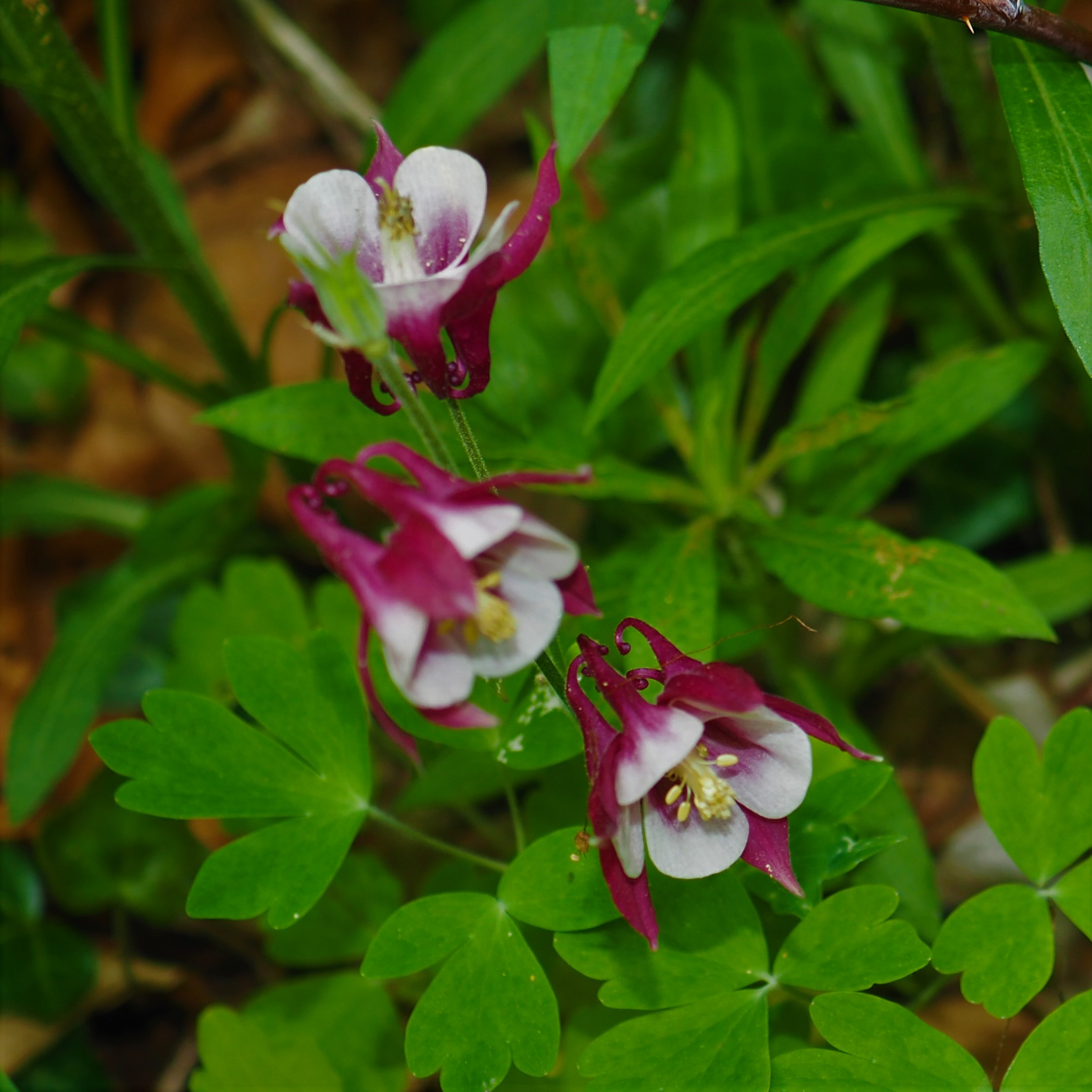
Remember that there is information in the name of the file for each image. You can see it by mousing over the image - look at the lower left of the screen. Or you can click on the image to get to the (usually) larger image. Then the info is displayed in the address line above. Sometimes the second click will actually display a different view of the original image.
The Ants are their usual busy bouncy selves, running up and down the Shop siding for leftovers. Here is an Eastern Black Carpenter Ant. Second is a Smaller Carpenter Ant. I was sure I had a picture of a Small Honey Ant. Where is it? Oh well, out in the side yard (picture 3), there were some Turfgrass Ants (Lasius neoniger) starting to get active - I think they were beginning to swarm last year about now .
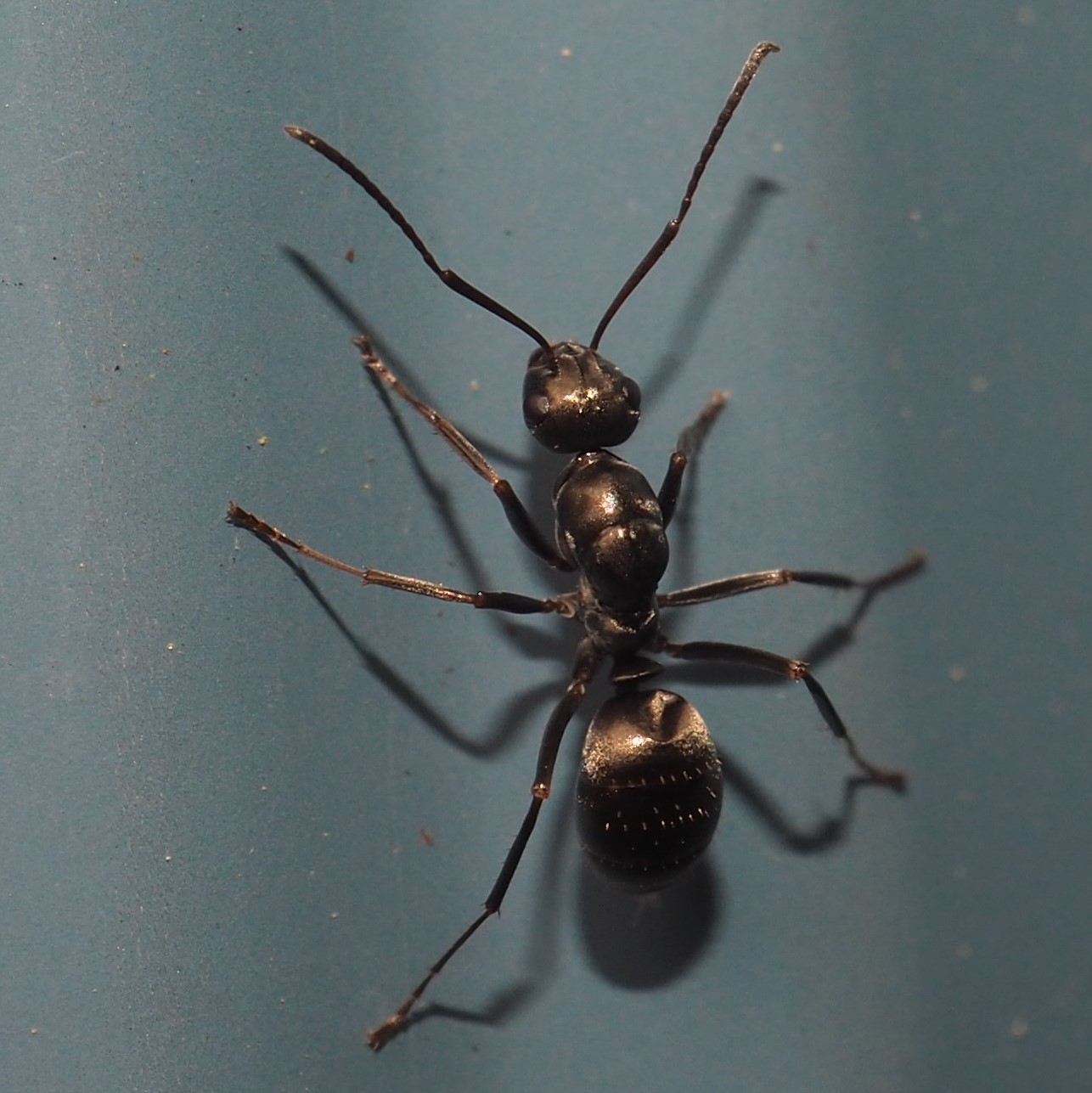
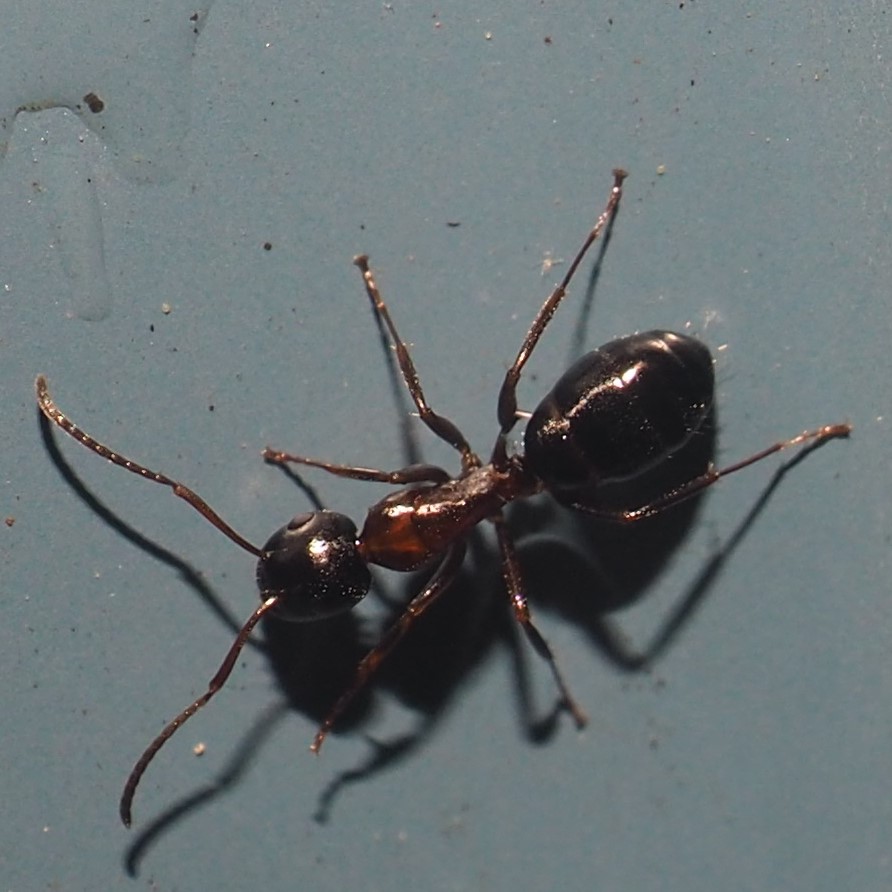
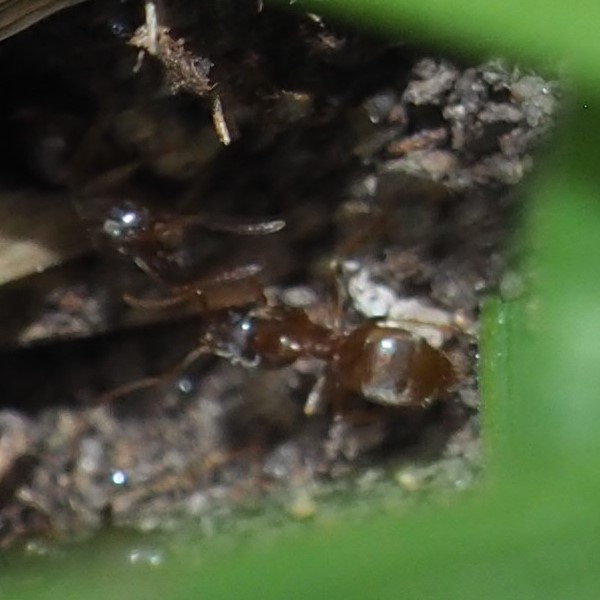
The exciting news last week was that a nest of eggs laid by an Ectopsocus meridionalis Barklouse began to hatch just in time for the Blog that week. Here are three nymphs we saw on May 25th. Picture 2 shows one of them up close. They seem to have moved away from the nest and today I couldn't see any of the babies. But here is an adult on May 27th. (Oops, my colleague Scott Shreve says this one is in the genus Lachesilla!)
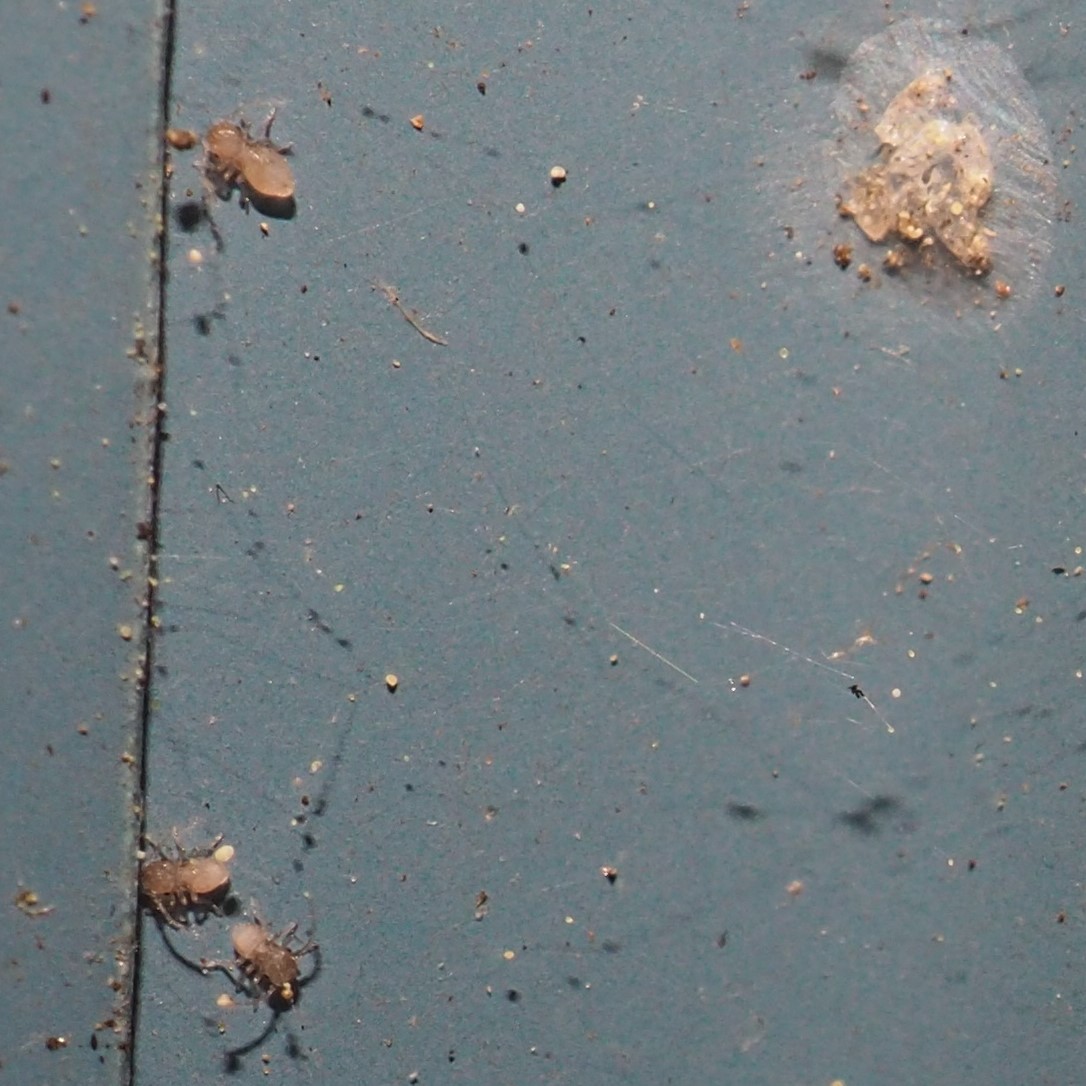
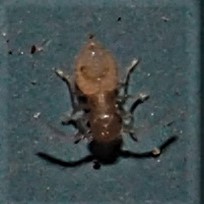
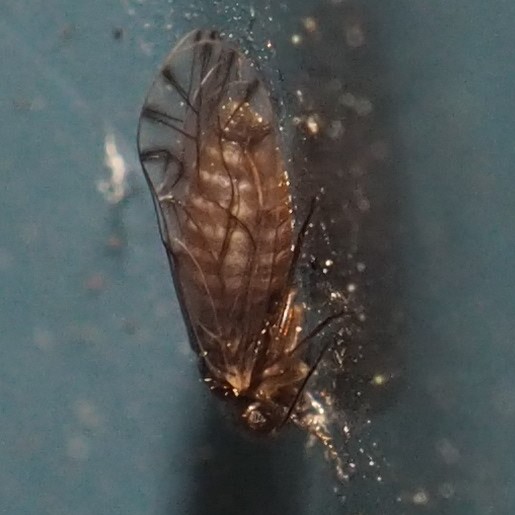
Yesterday (May 27) gave us a big surprise, as down at the bottom of panel 10 on the North wall, suddenly we were treated to the sight of a large group of a different kind and size of Barklouse. I don't think I've seen anything this size and color before. Picture 2 shows a second smaller group further down the panel but not far from the big group. I was really looking forward to watching that little pack of newbies grow, but Thursday night we were treated to a beating rain and so today Panel 10 was emptied of those little fellows. My hope is that they managed to get to the bottom of the wall and run inside the panel. Update: May 29, the day after the day after the rain, we found a few babies.

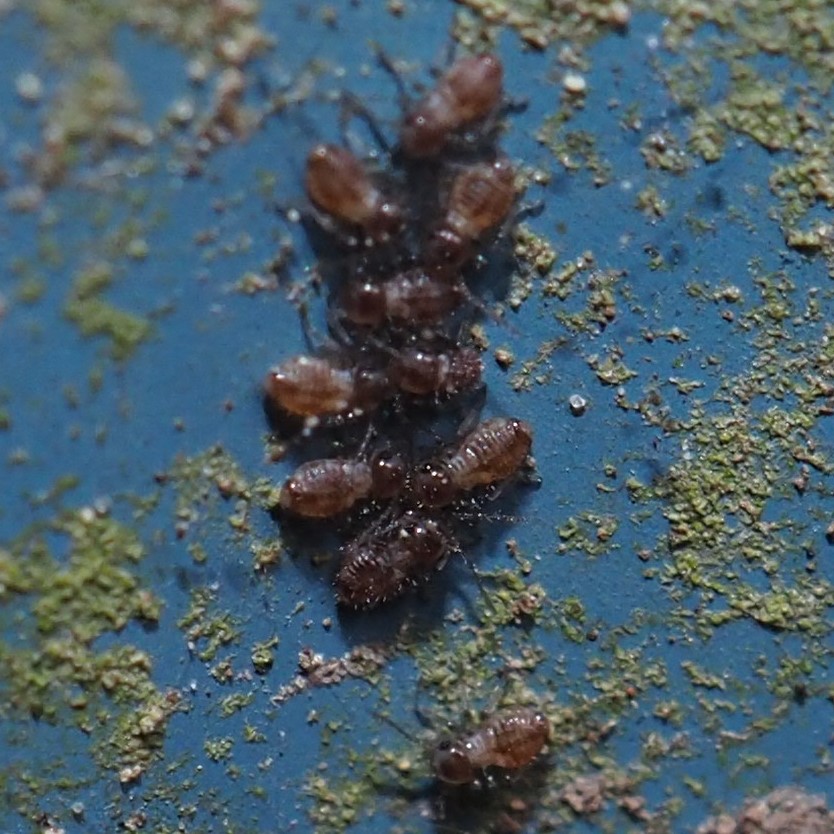
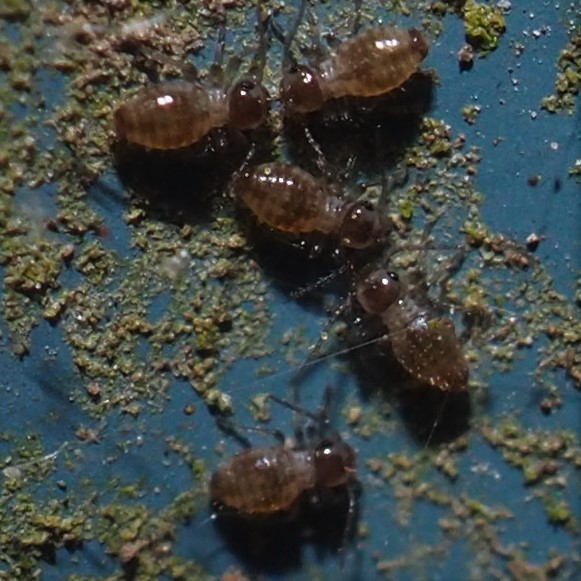
So we will have to keep an eye out for some of those nymphs, maybe even not far from where we first saw them. And maybe what you see will be another amazing thing. A couple of days ago, this Fly landed on the Wall right in front of me. It was so little I had to really work to get it into focus - and meant that the Fly had time to change into a Barklouse (note irony), maybe even one in genus Ectopsocus!
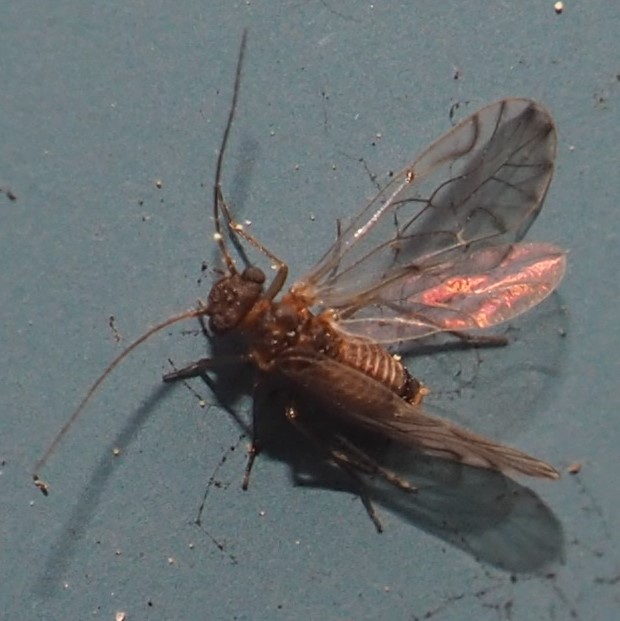
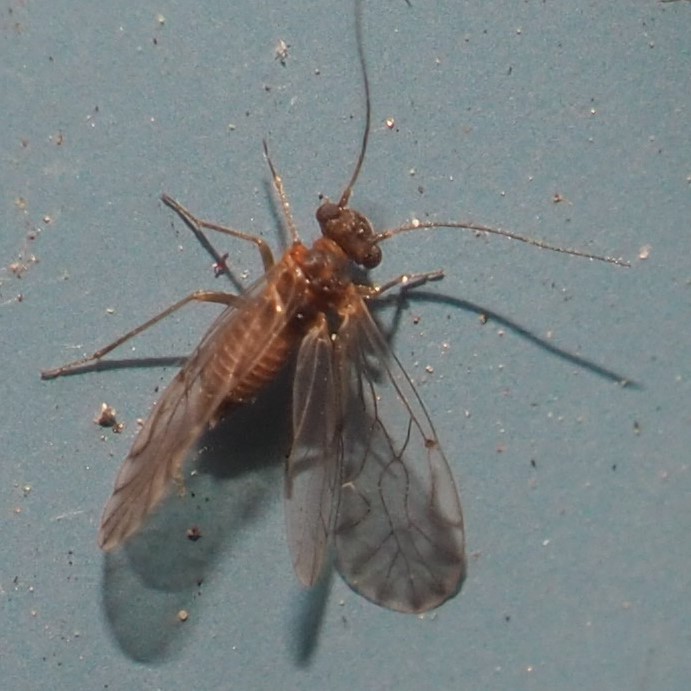
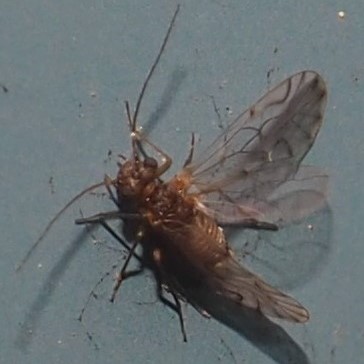
Meanwhile, day by day, more and more of those tiny Graphopsocus cruciatus nymphs convert themselves into adults with those gorgeous tiger-like wings. Now we can start our clock that counts down to the time when the adult females begin to lay new eggs. Oh! I was going to show you an old picture from last year but right after that I took a break to see what new pictures we had today and voilà! Here is the picture of one of the adults laying a sizeable clutch of lovely fresh Graphopsocus eggs!
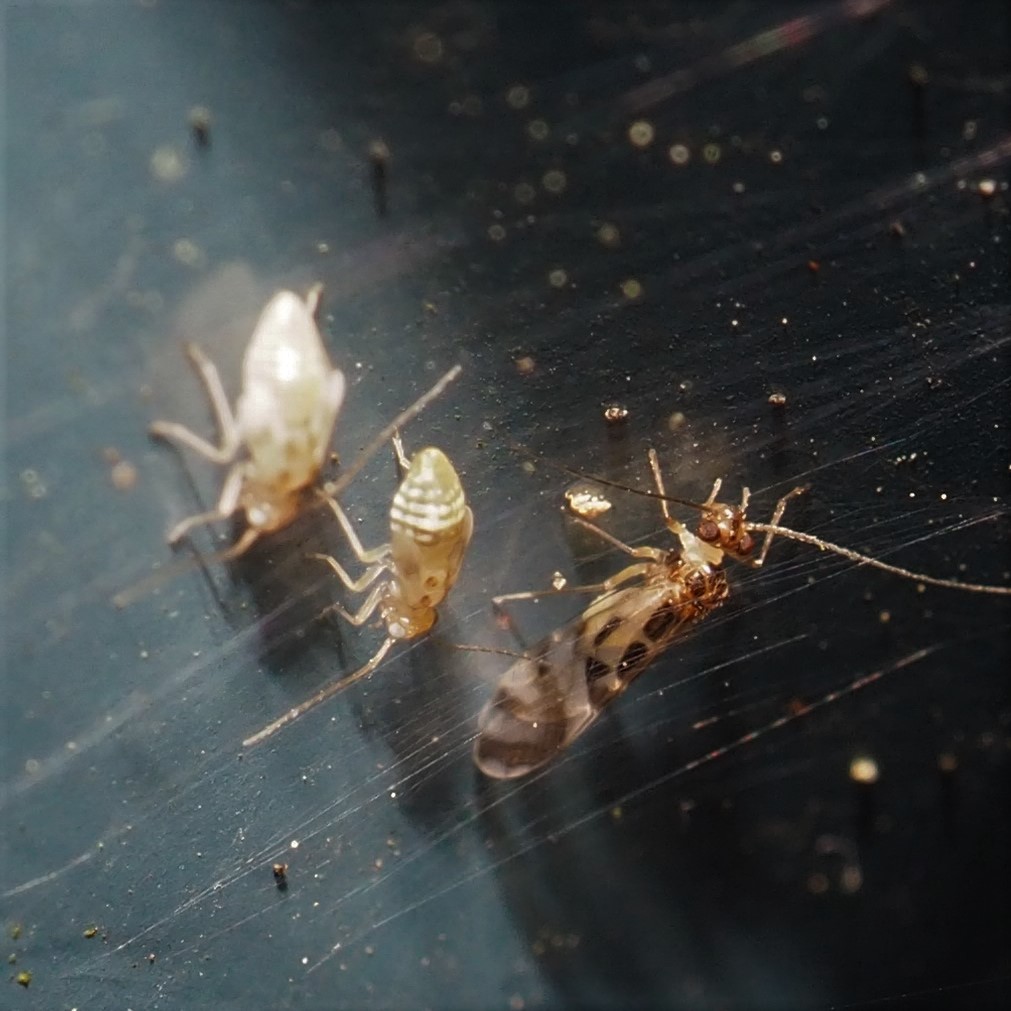
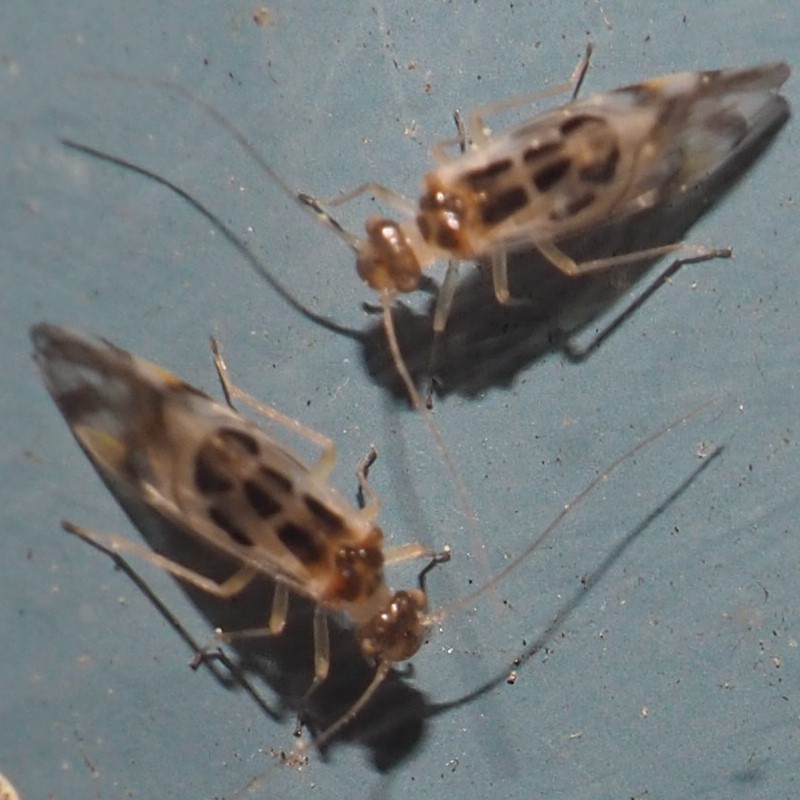
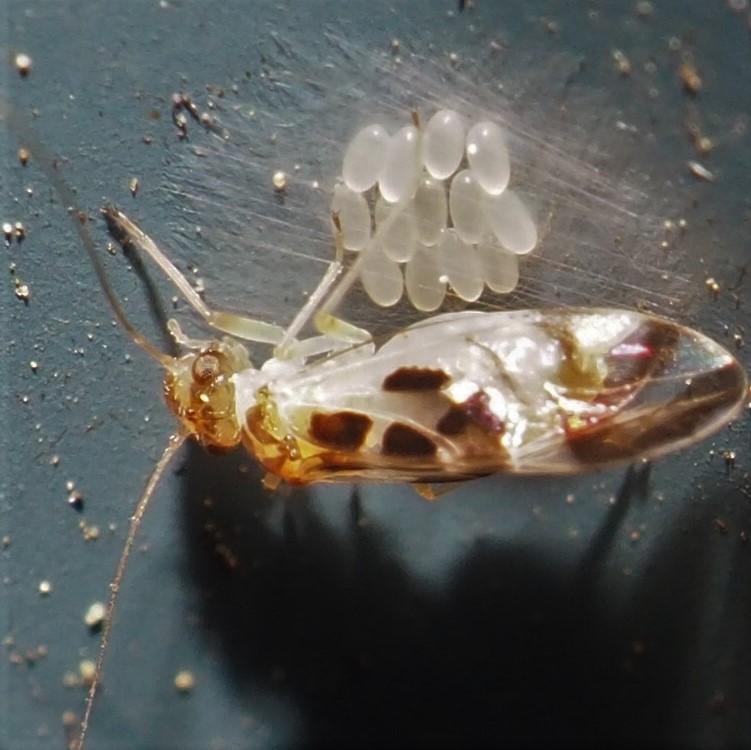
In parallel with the rise and fall of Graphopsocus cruciatus, we are starting to find a few of those beautiful yellow-orange Valenzuela nymphs and adults. (Maybe it's because they move around quite a bit!) This first one was a nymph from last week's photo gallery - note its wings are only about half grown; also note the reddish eyes and yellow-orange overall color. Next, an adult Valenzuela flavidus, lateral view; and a dorsal view taken a few days ago. Note that the reddish eyes carry over from nymph to adult.
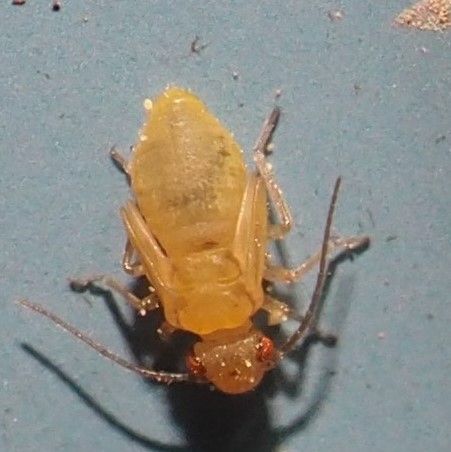
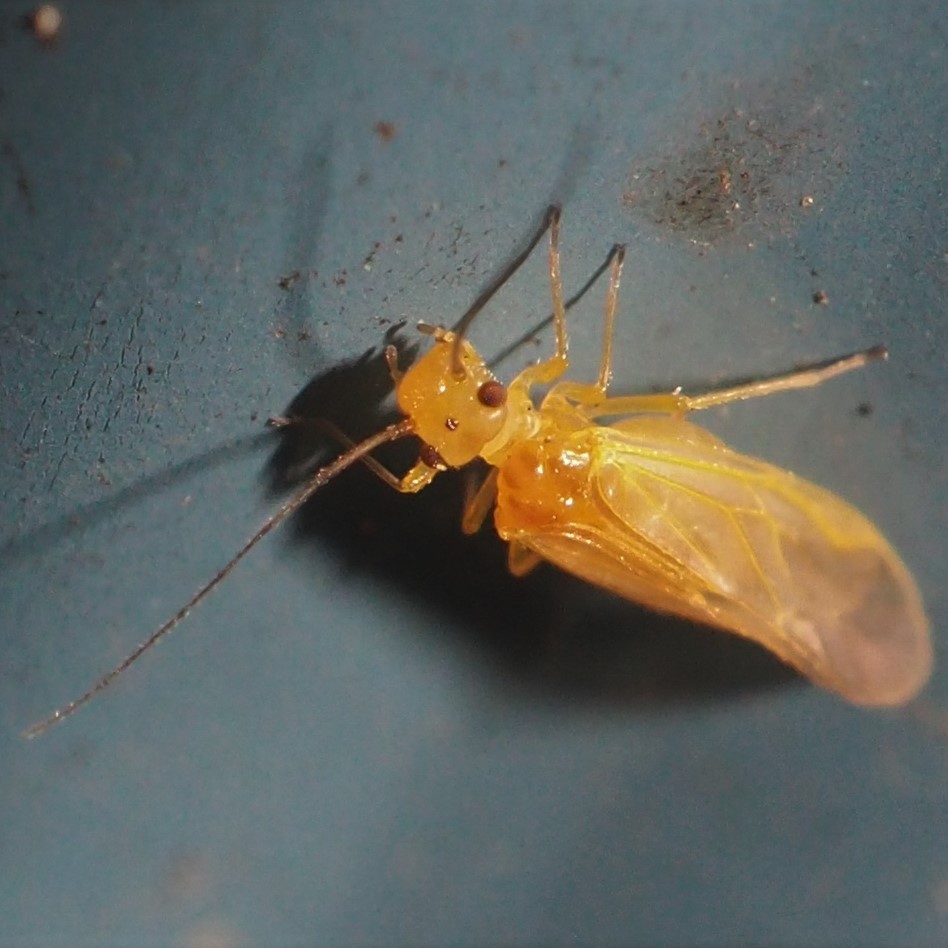
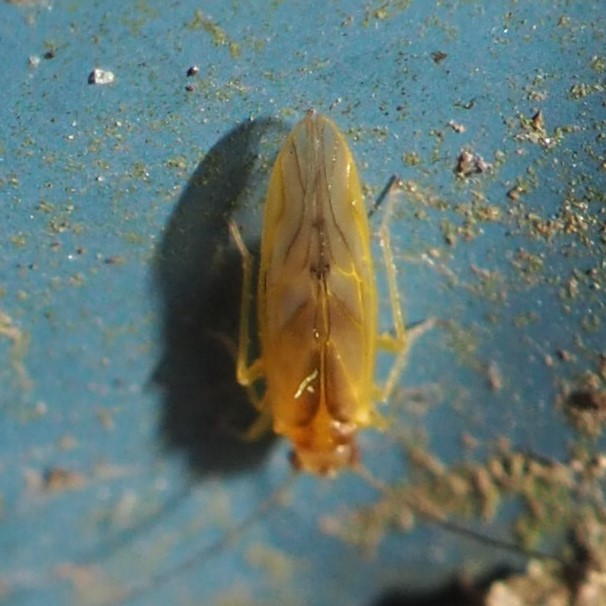
The Goutweed, that persistent ground cover, is back, just starting its season of welcoming all kinds of creatures that don't come to a lot of other plants. Here you see a bee in the Goutweed. Maybe someone on iNat will find an ID for it. This brownish-red Beetle turns out to be a Hairy Spider Weevil. I asked Boris
Büche of Berlin if it ate Spiders, and he said no, but gave me a big list of Beetles that do eat other Insects or Spiders. Boris has been a terrific source of information on Beetles of all kinds. You'll see an example in just a little bit now. Next, this black Beetle with the Red spot on each wing is called the Twice-stabbed Beetle. And last, this lovely black Rove Beetle (the one with a shortened hard outer wing) is in genus Anotylus.
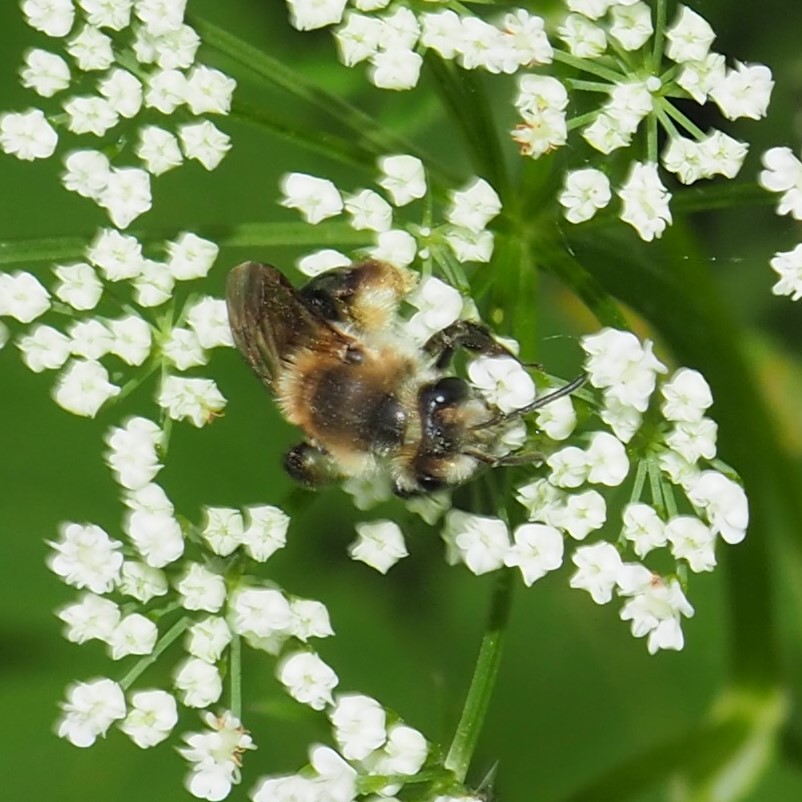
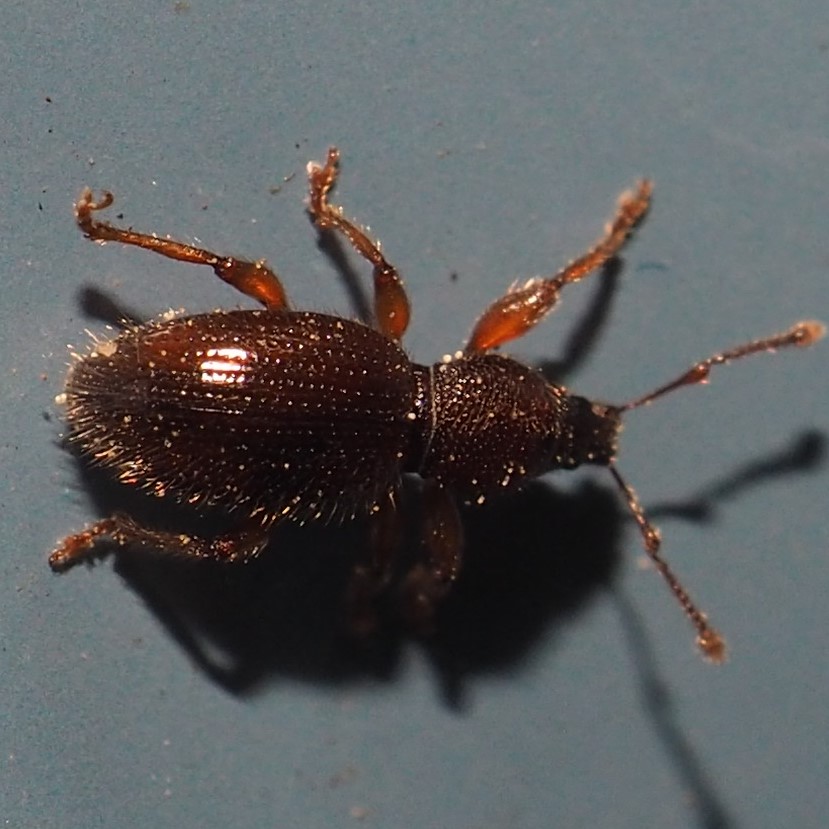
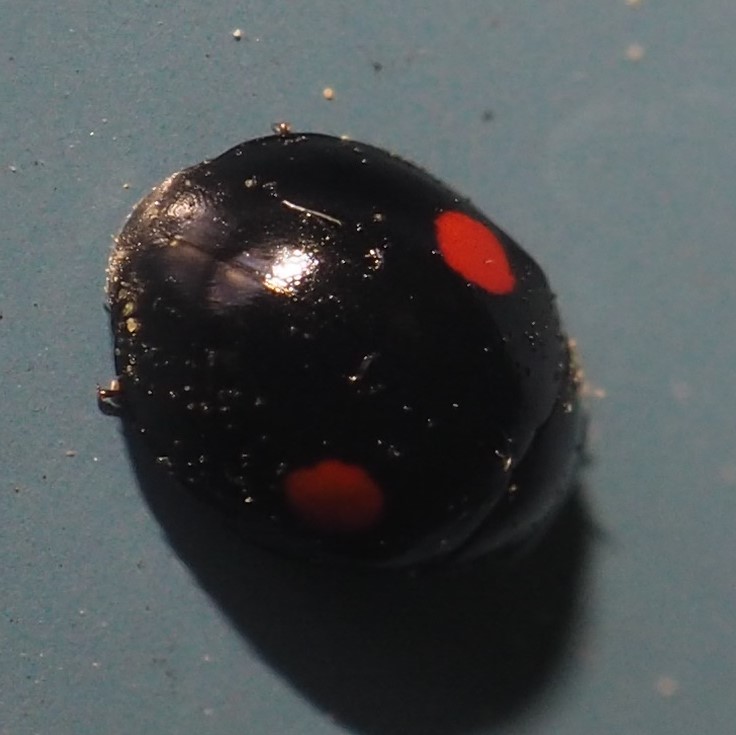
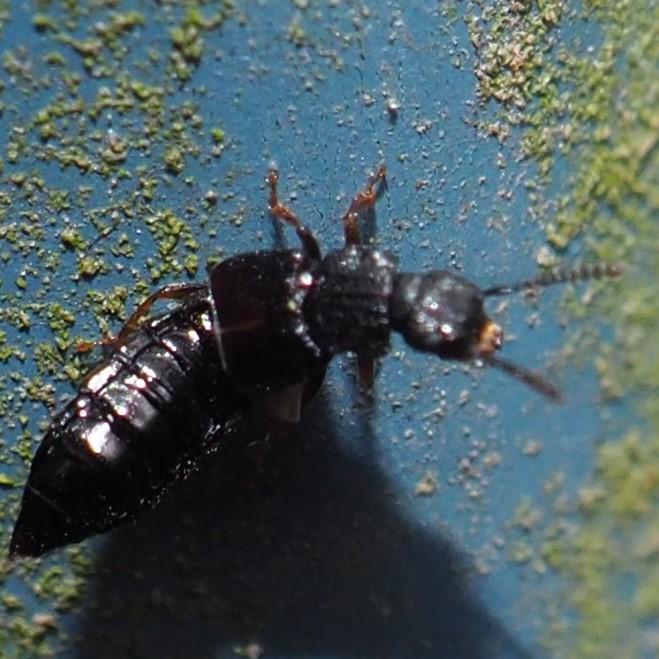
I want to give a lot of space to something that happened on May 23. Several times in the past few years, I've submitted a Weevil to iNat, and the furthest it has gone to being identified is that it lies in genus Ceutorhynchus. But on this day, Boris Büche responded with an unusual question, do you have this plant nearby? and showed a picture of our beloved Dame's Rocket. Now it just so happens that our Dame's Rocket is still blooming fairly strongly, and so I replied to the affirmative. Then he suggested that if I would shake this plant over an umbrella (a large Tupperware container turned out to be just fine) and look to see if any little weevils would fall out. Well, guess what! The shake-out from the flowers contained about a dozen weevils. I photographed them and sent them back in to iNat, and Boris immediatedly identified them as Ceutorhynchus inaffectatus, a species that seems to live in the pods (or flowers if pods hadn't formed) of Dame's Rocket.
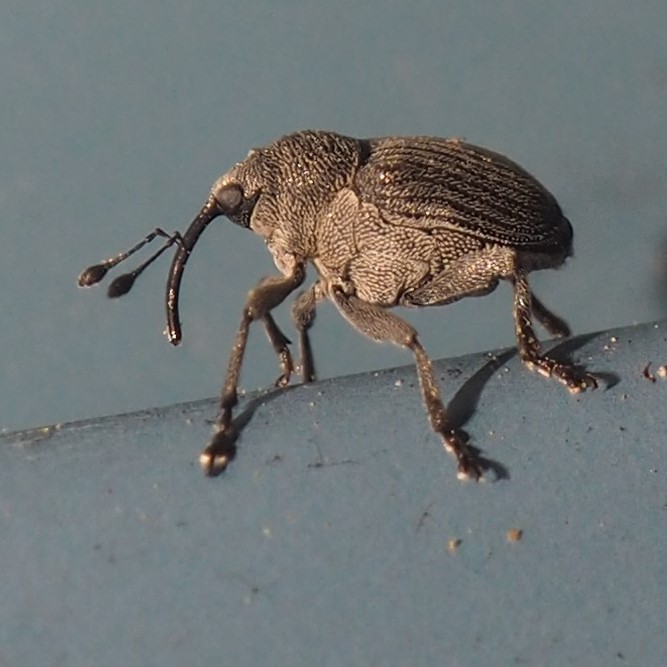


Here are more pictures.



But the thing you might be interested in is this interchange. You know how often I go on and on about how much it's meant to me in my retirement to continue to have colleagues throughout the website iNaturalist.org. This is an example.
Here's a continuation. Thanks especially to Boris Büche and Sam Kieschnick, two great colleagues. Thanks also to whoever designed iNaturalist.org so that people internationally and of all backgrounds can contribute to the advancement of our knowledge of our environment. I also want to thank all of you readers of this Blog. Your questions, comments and photos add greatly to this cause! I don't say that often enough!
A few more Beetles. Sometimes they come in colors it would be hard to imitate. Like this Eurasian Red-and-black Melyrid. What a shock of color and form.


To the Bugs. I only have a few shots of Zelus luridus this week, unlike last week's plethora of adults and nymphs. These delicate-looking Bugs make it hard to imagine what formidable terror they would render if we were their size! Second is our newish friend, Empicoris errabundus, again a juvenile form, and another kind of Assassin Bug. We also saw quite a few tiny Creatures that may or may not be Leafhoppers. Here is what may be the Four-spotted Clover Leafhopper, Agallia quadripunctata. At least we can be sure it IS a Leafhopper, and that it is in genus Agallia.
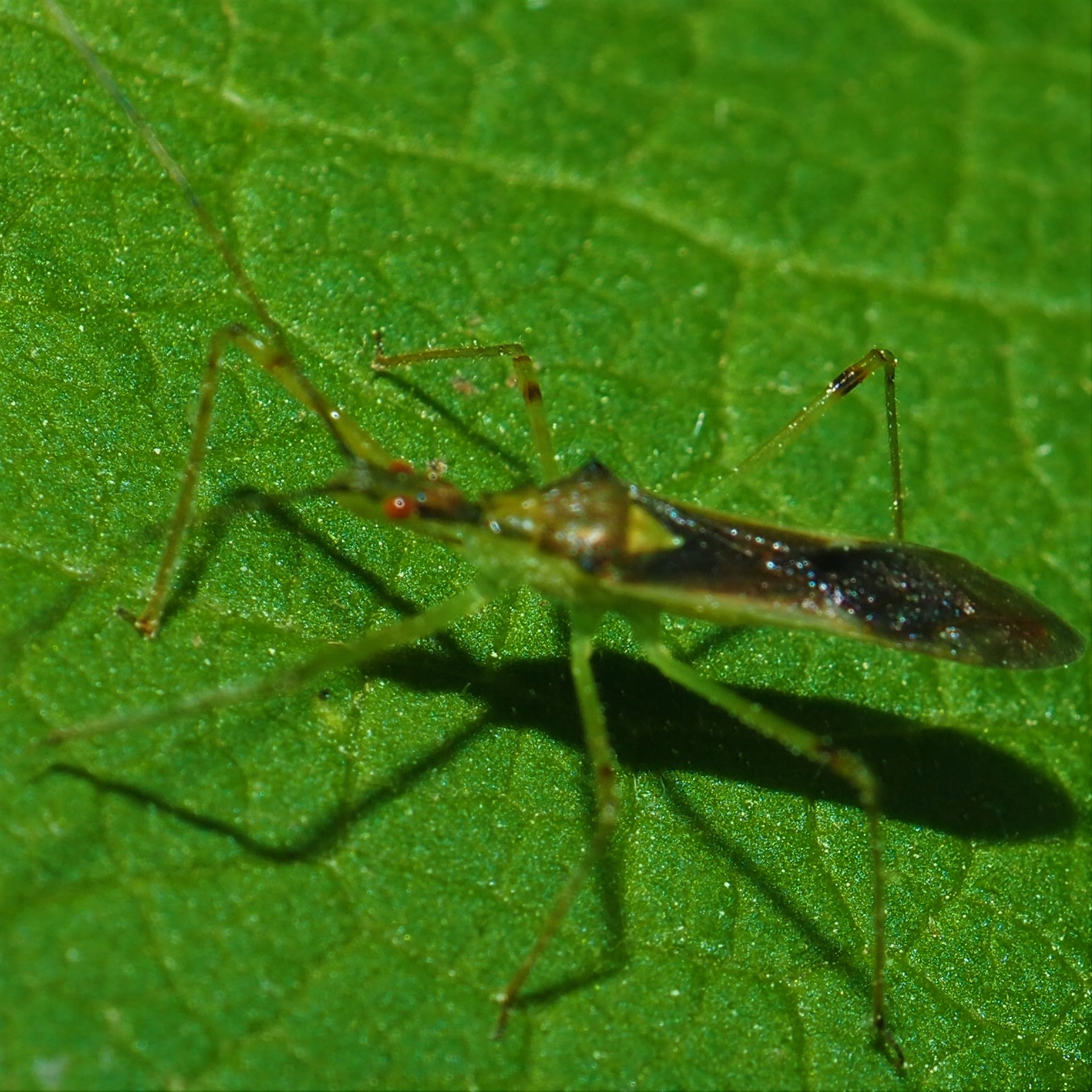
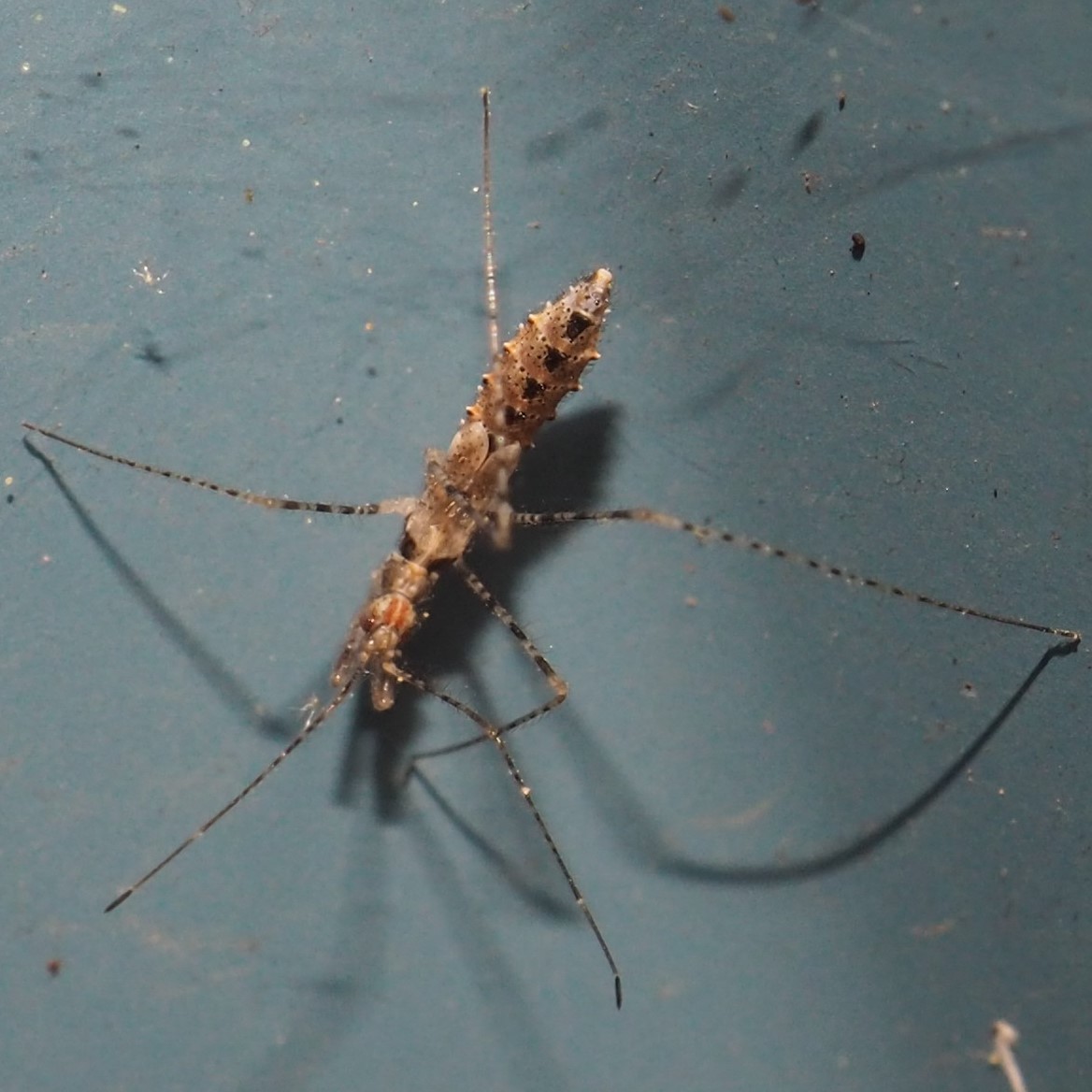
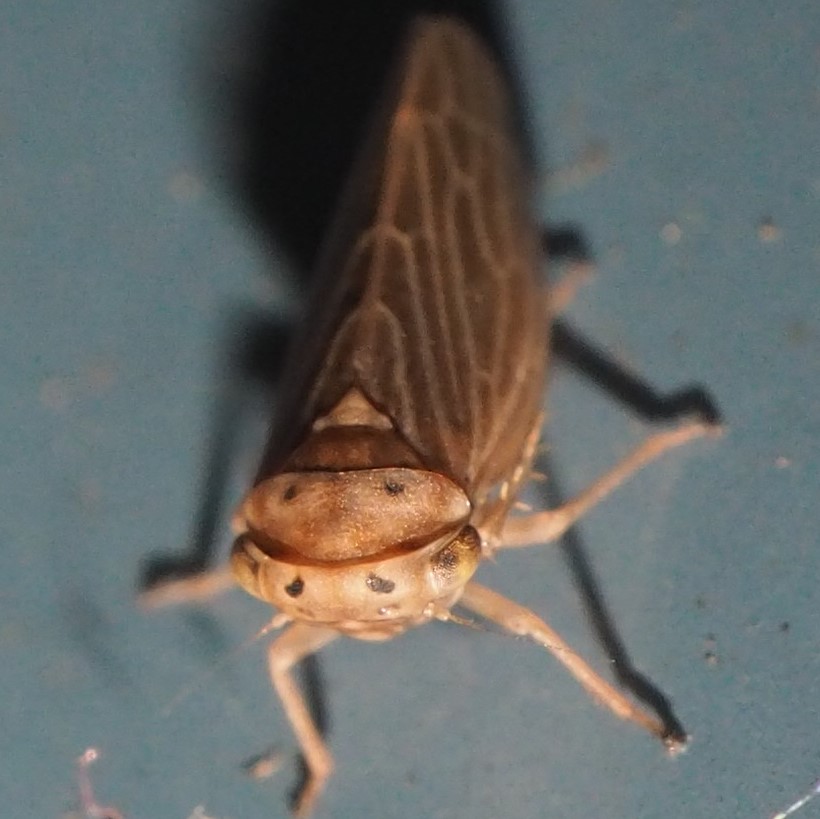
Here are some more Bugs. We really are in a holding pattern until the great variety of Leafhoppers comes in. What do you think these little guys are? I think Leafhopper for the first one. Maybe number 2 is a small Plant Bug. Number 3 has been identified as a Plant Bug. I wonder what it is staring at.
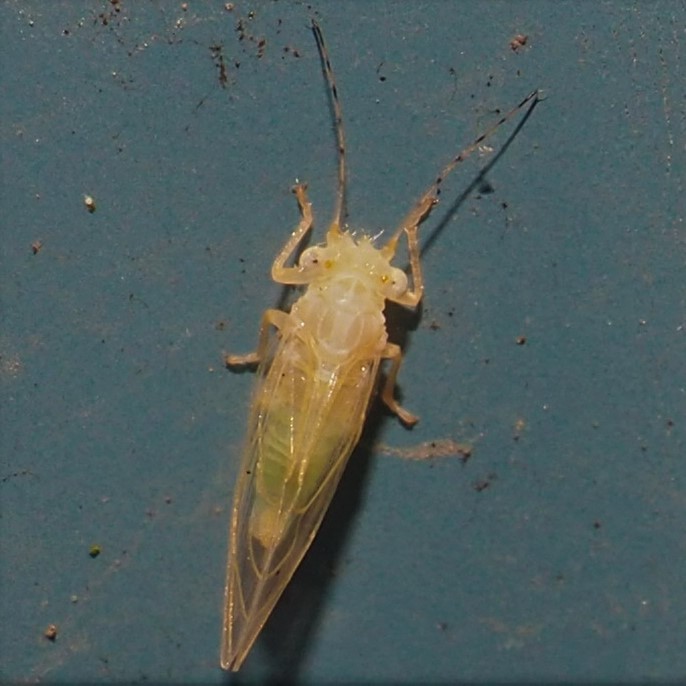

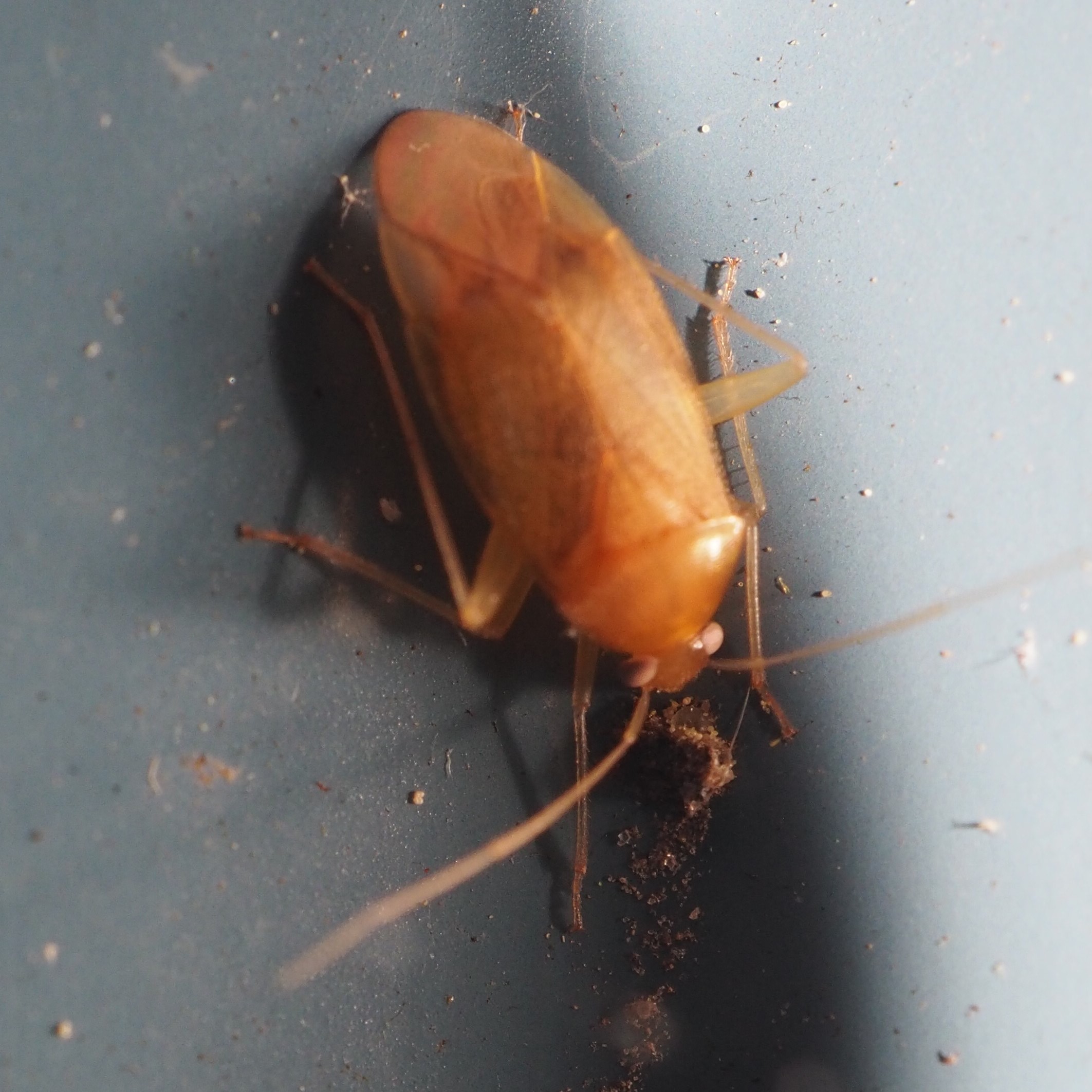
Usually we would have seen a few more Odonates (Dragonflies and Damselflies) by now in the season. This is, however, the ONE I always look forward to seeing. It is the male Ebony Jewelwing. Look for it in your yard, especially if you have a pond or other water source.
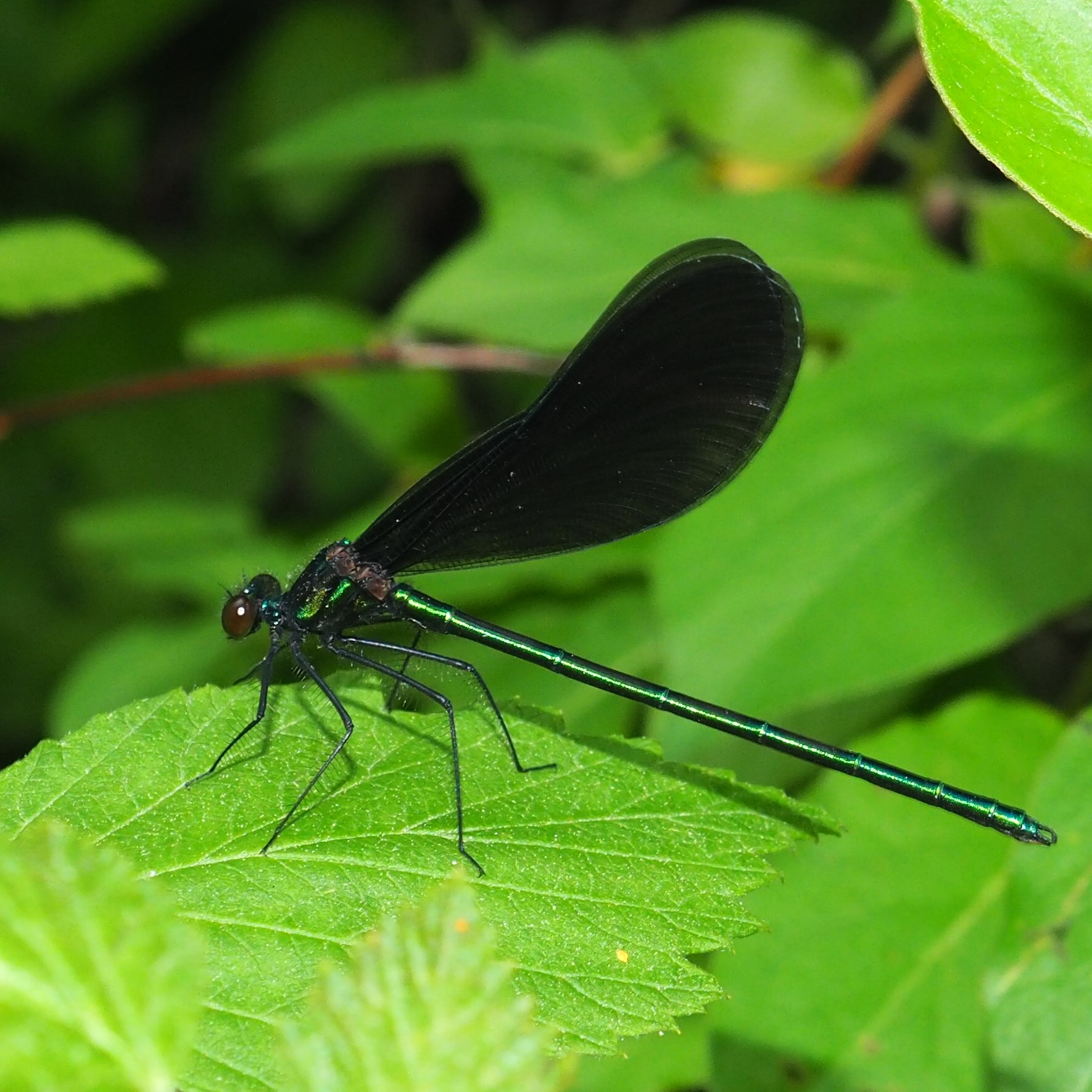
So we find ourselves in the Flies. First up is yet another White-winged March Fly. Then probably a Fungus Gnat. Third was guessed at by the ID app in iNat as a Biting Midge. Whatever it is, there are two of them, probably mating!
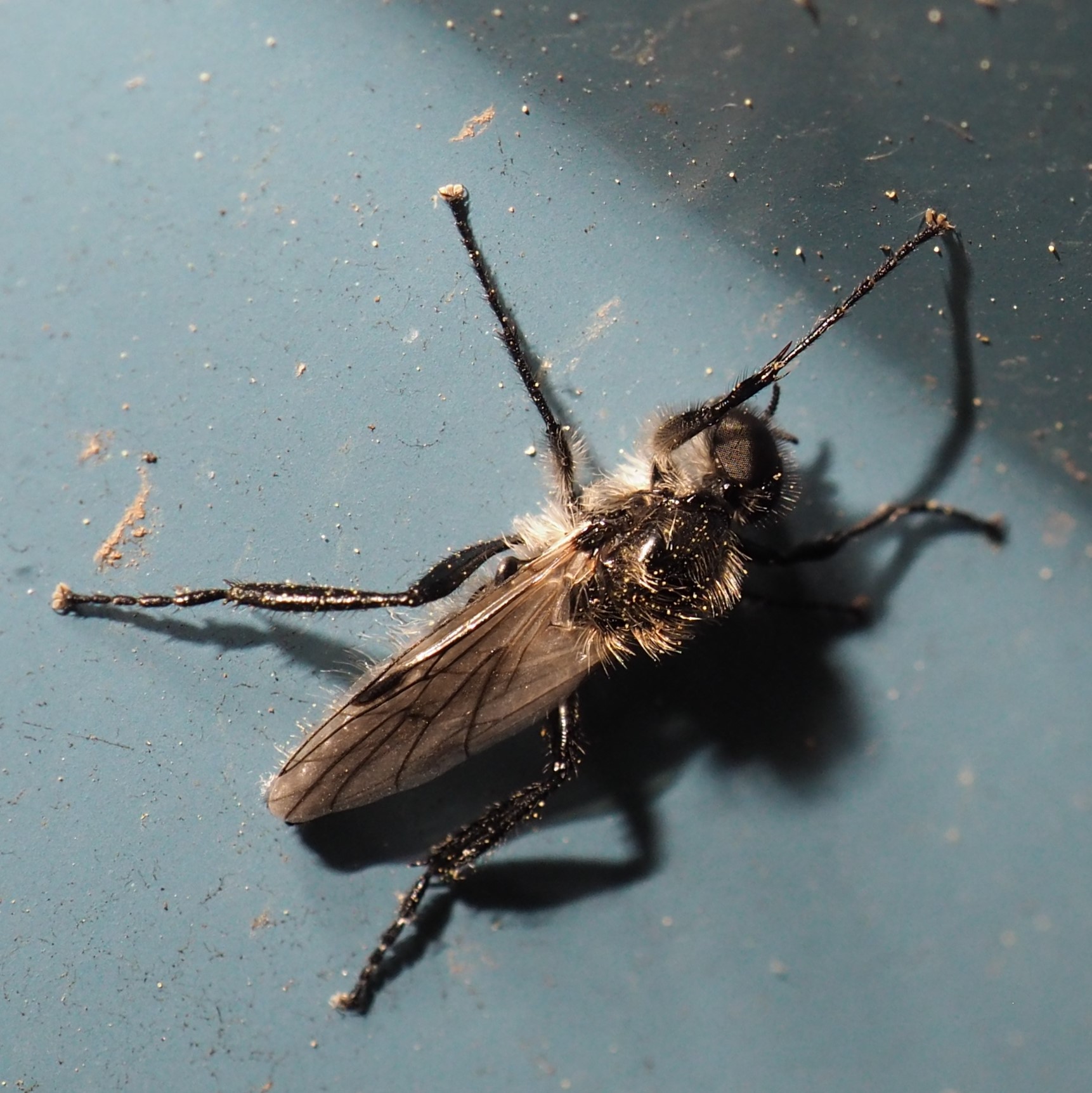
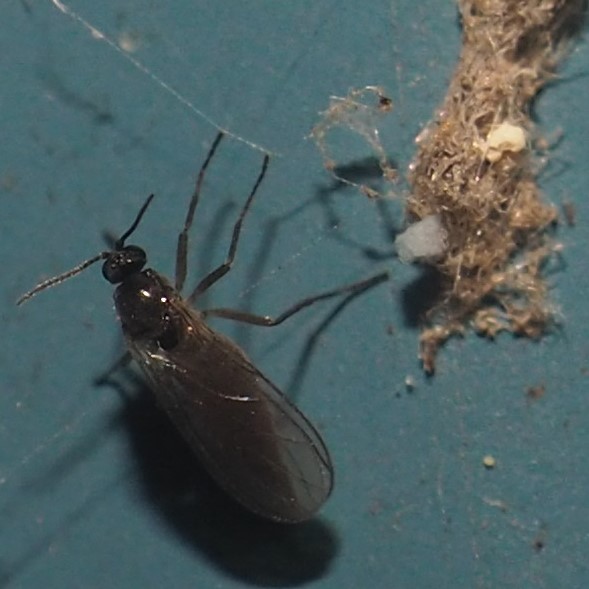
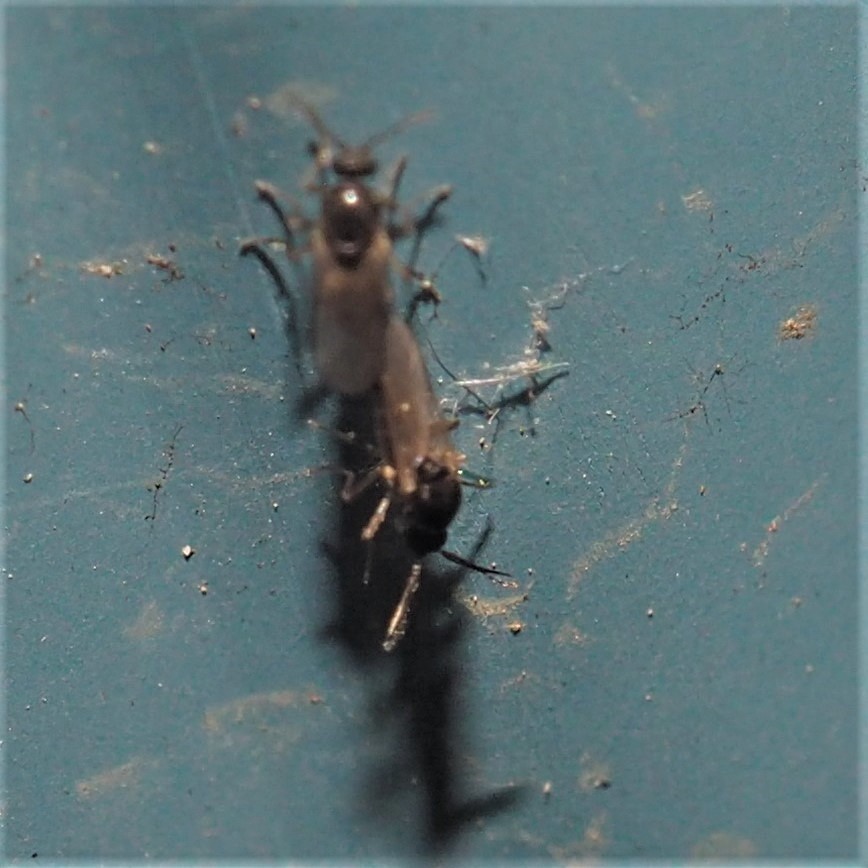
The tiny little Long-legged Flies are still among us. This first picture was from May 23 last week, then two from the 28th.
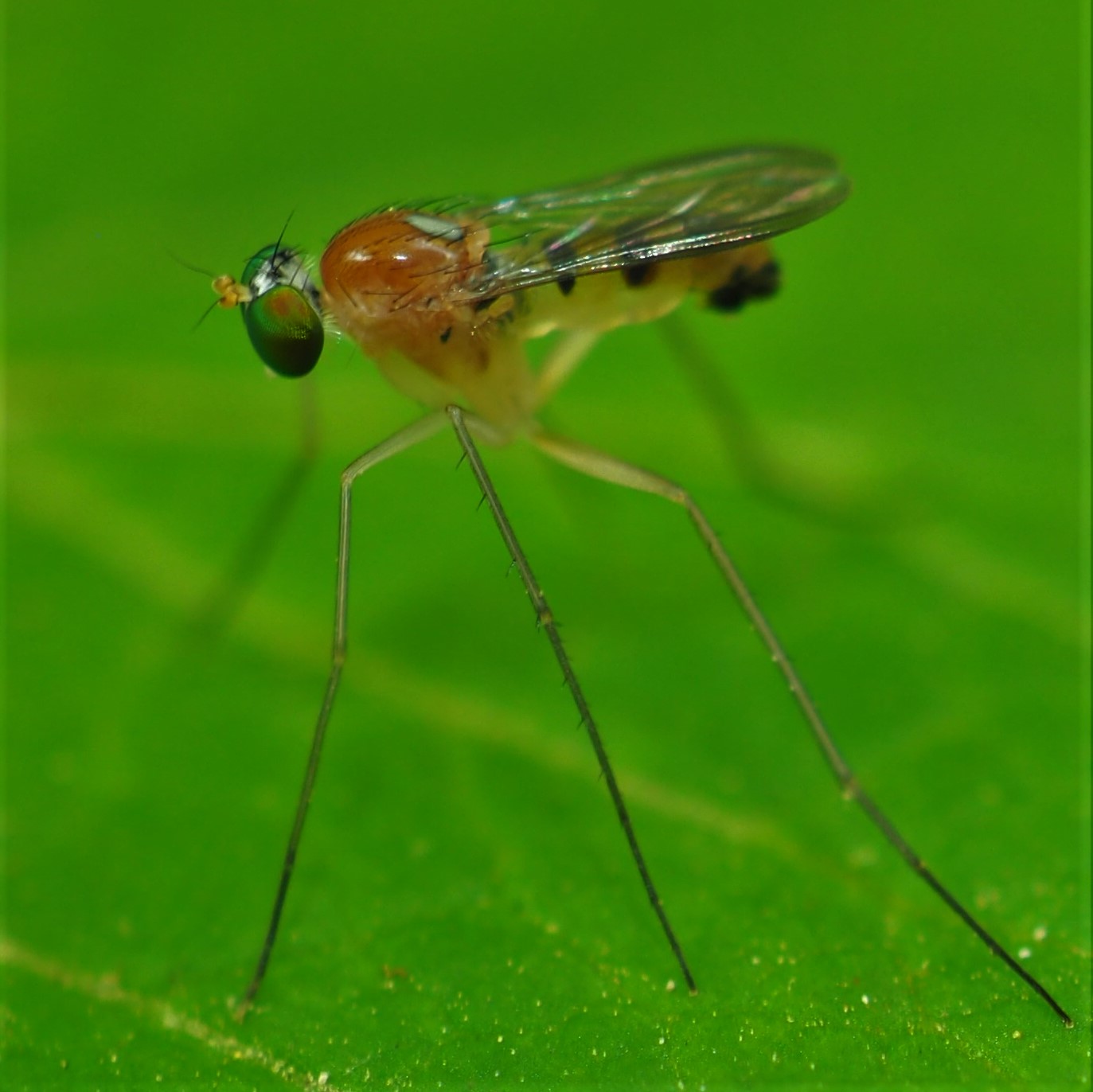
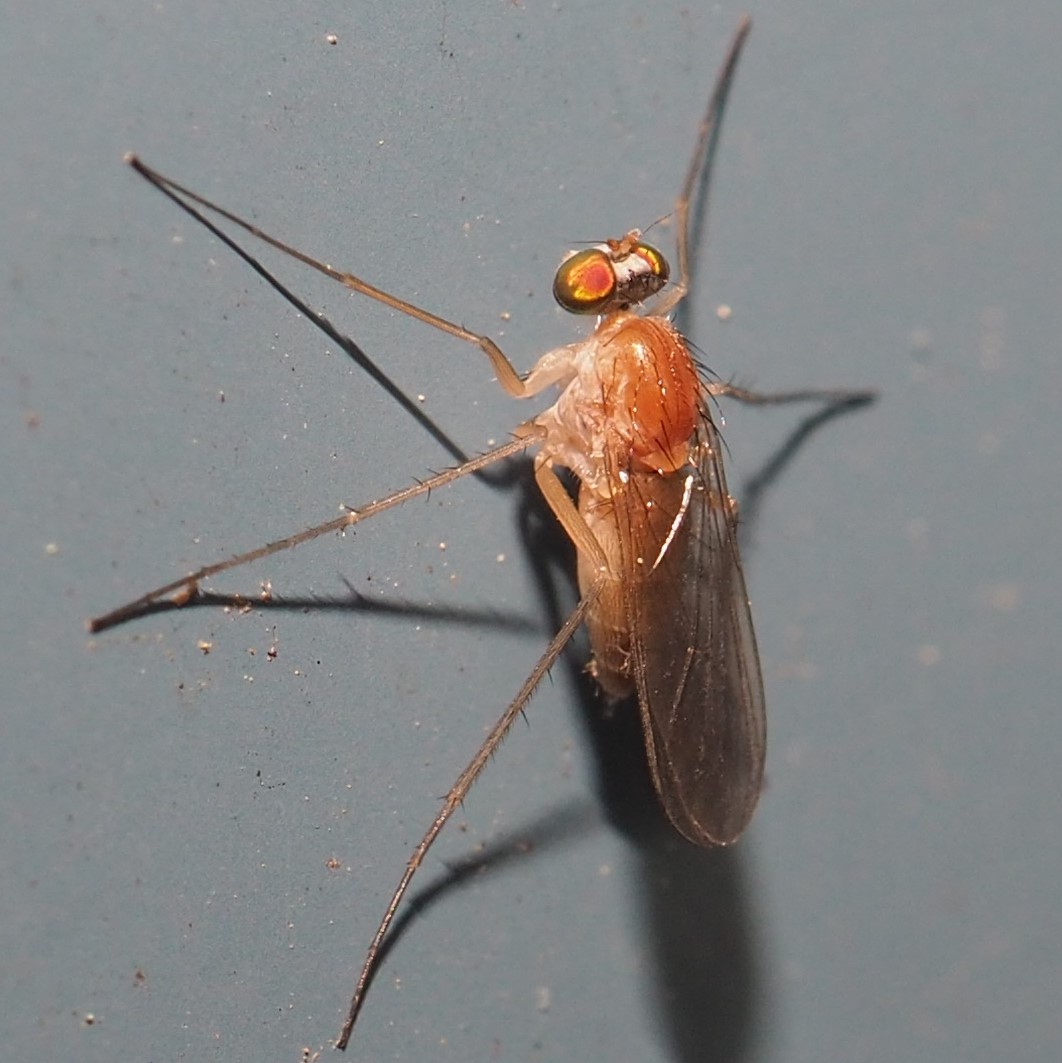
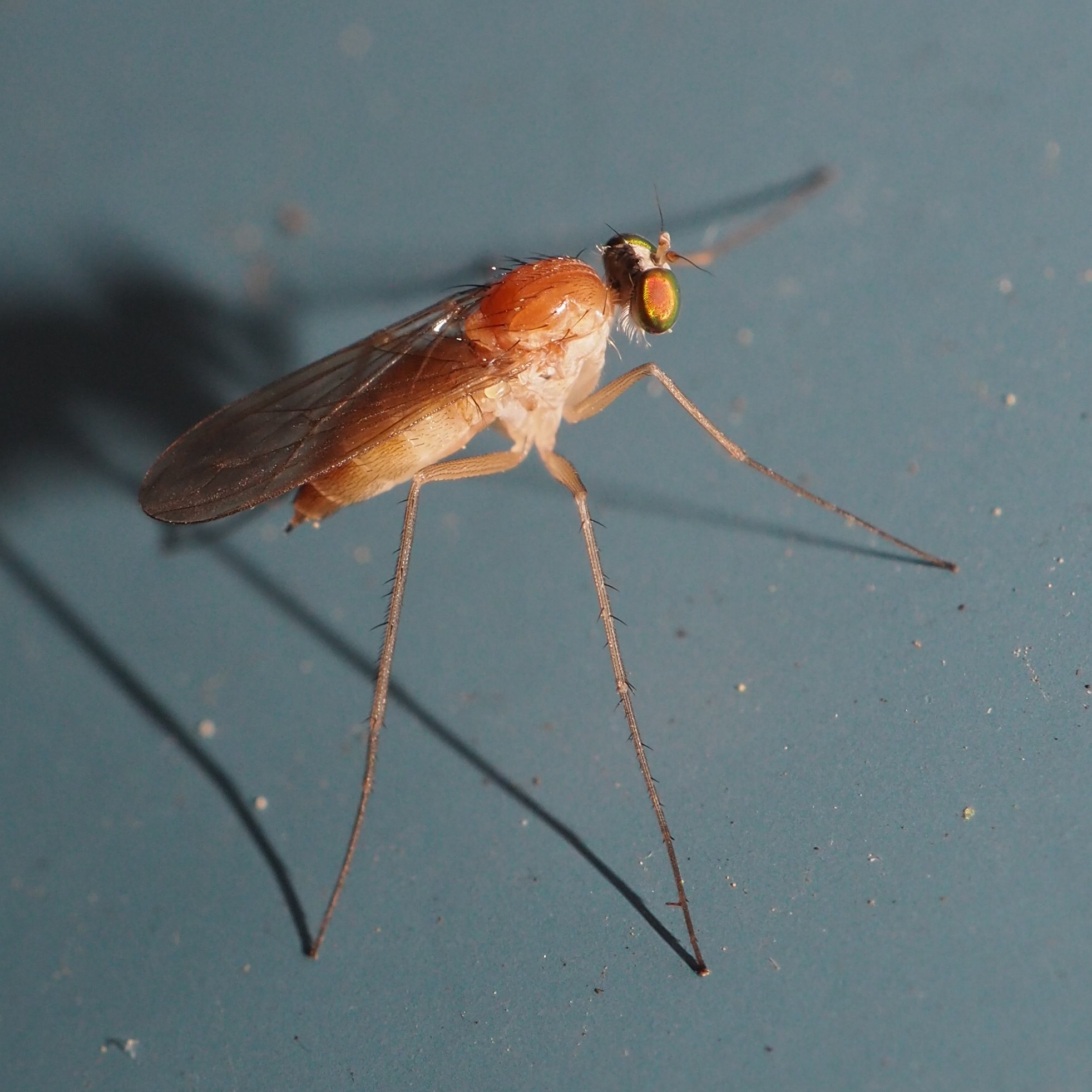
Here we have a Fly, probably a Midge, that has the photographic challenge of being about the color of its background, the brick color of the house front.
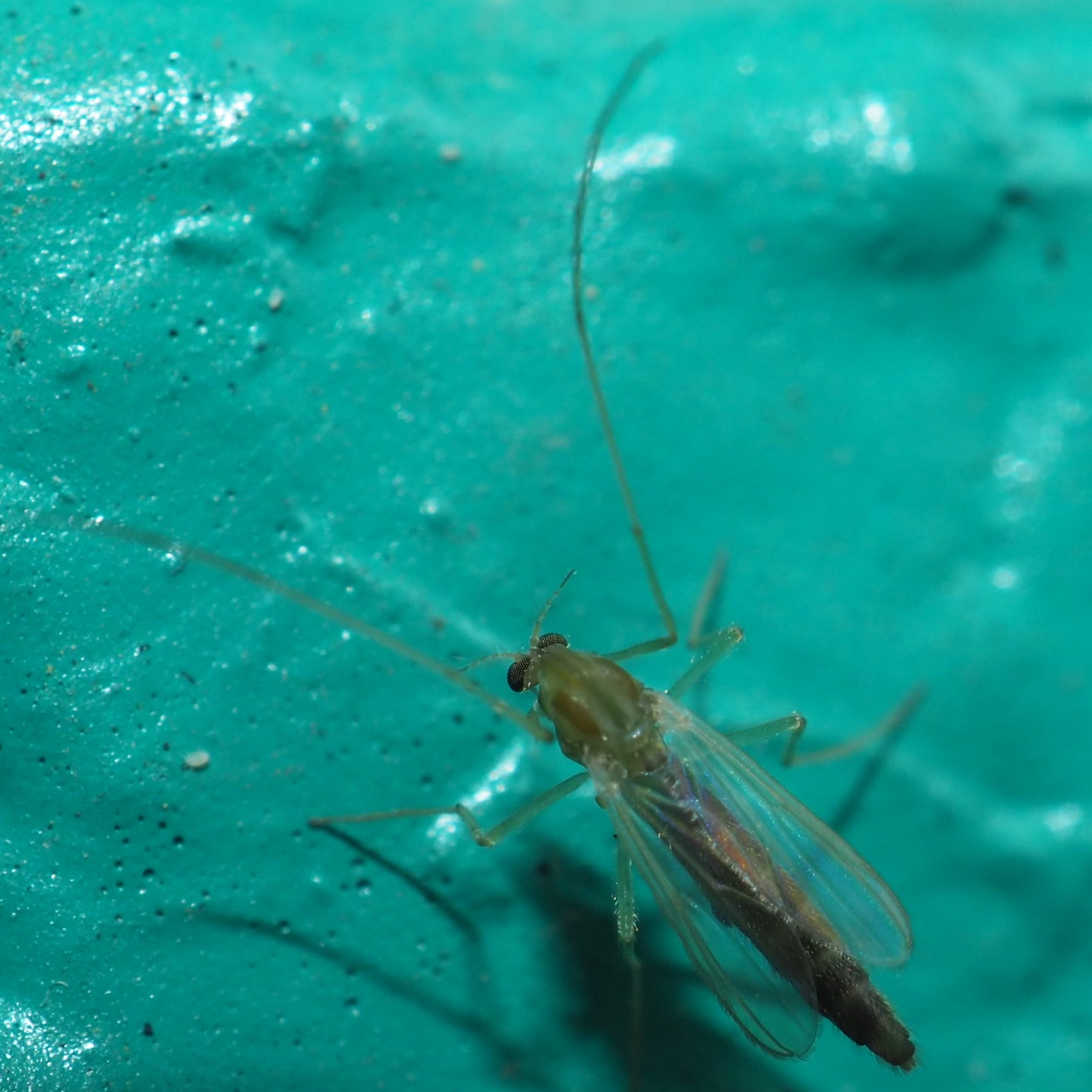

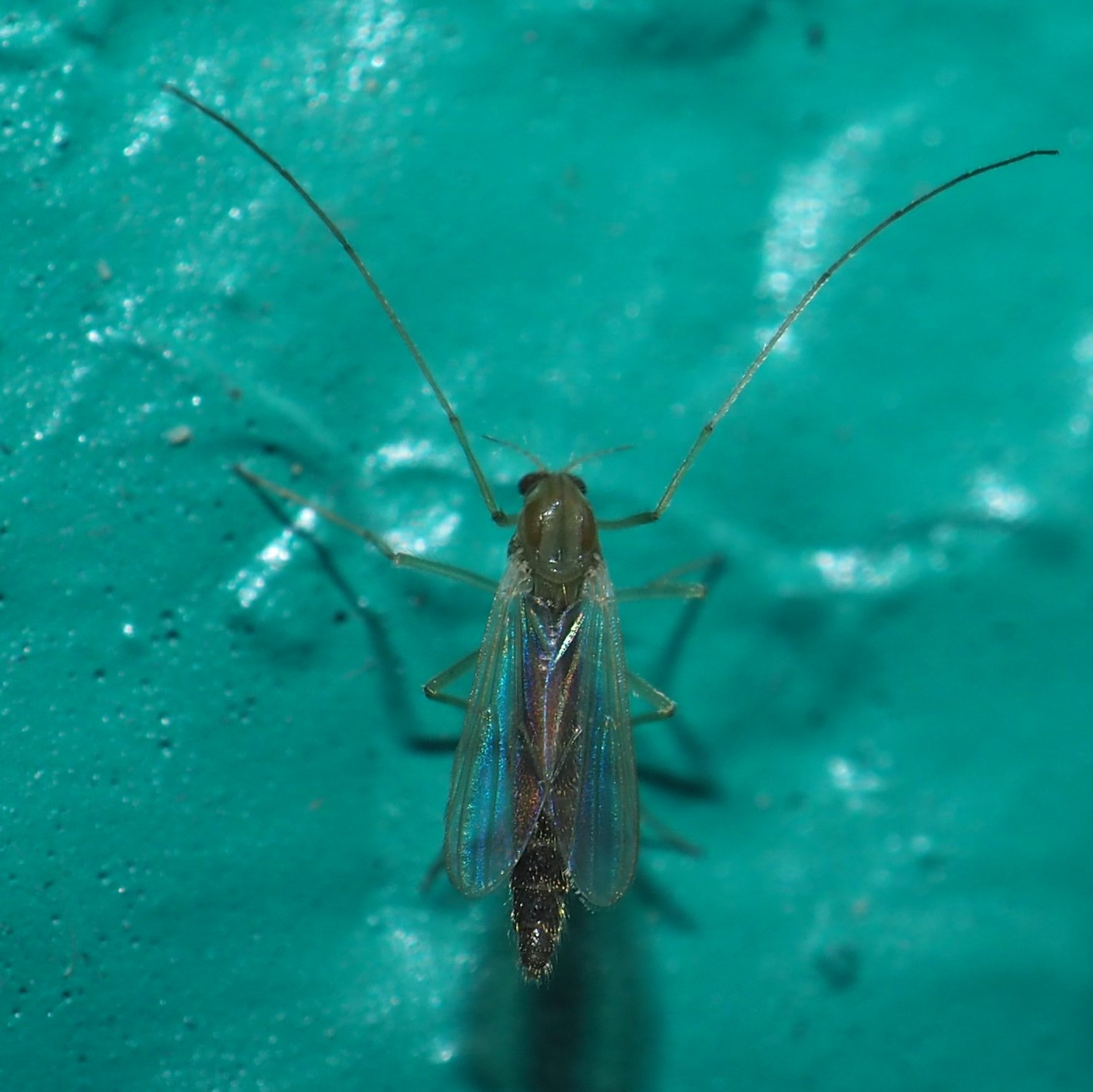
All Midges. Number three was ID'd as a Gall or Forest Midge.

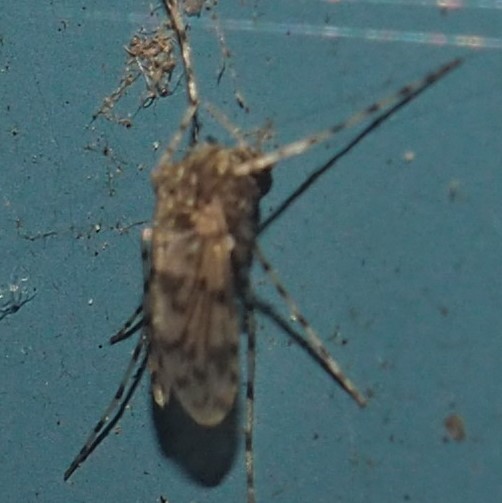

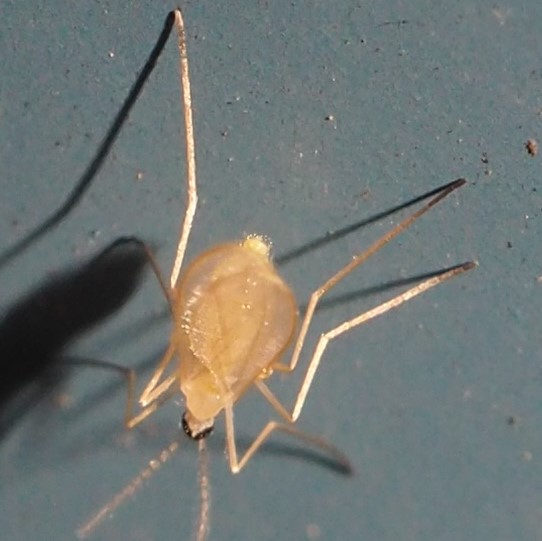
A few mysteries - Midge or Mosquito?
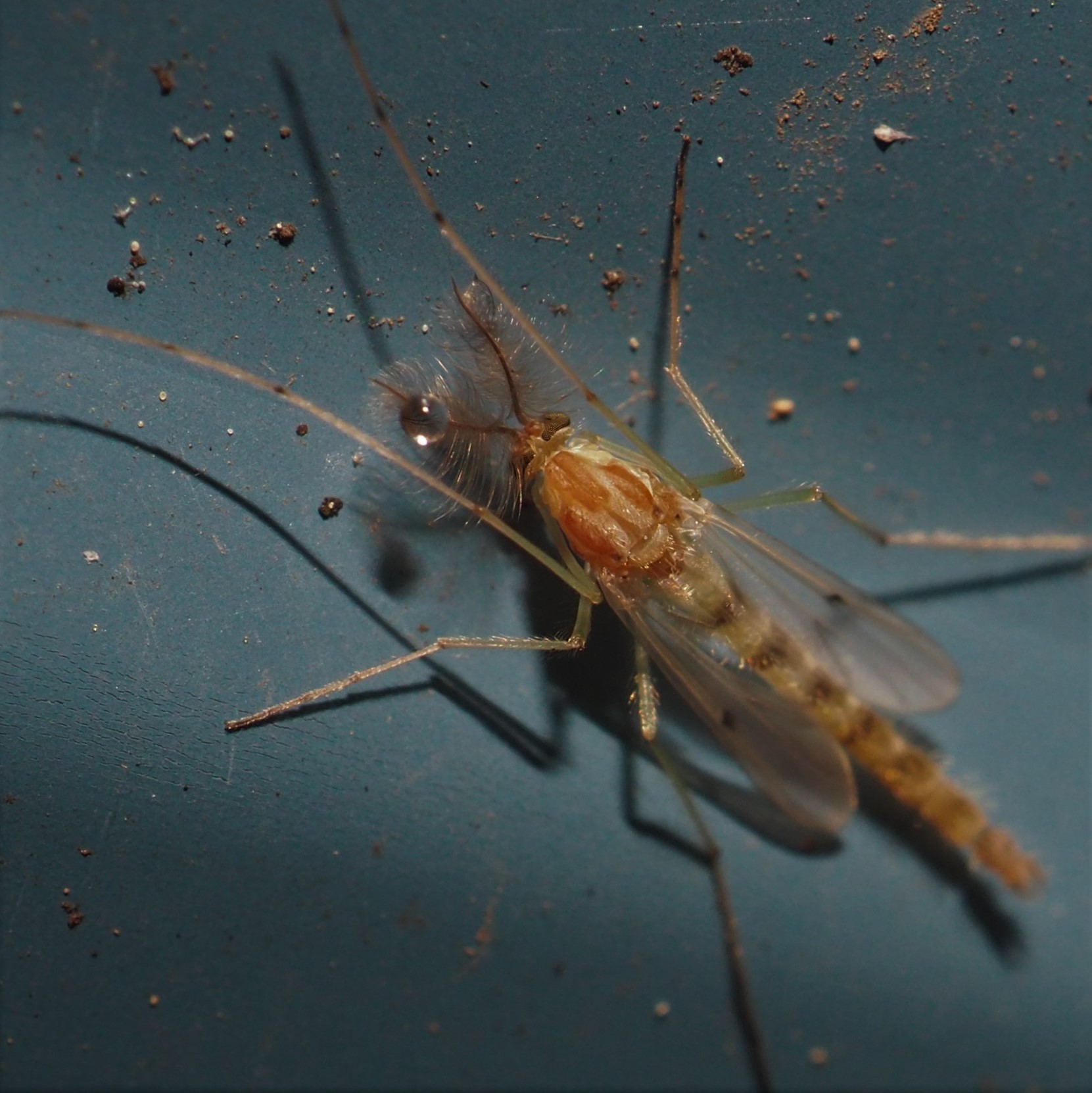
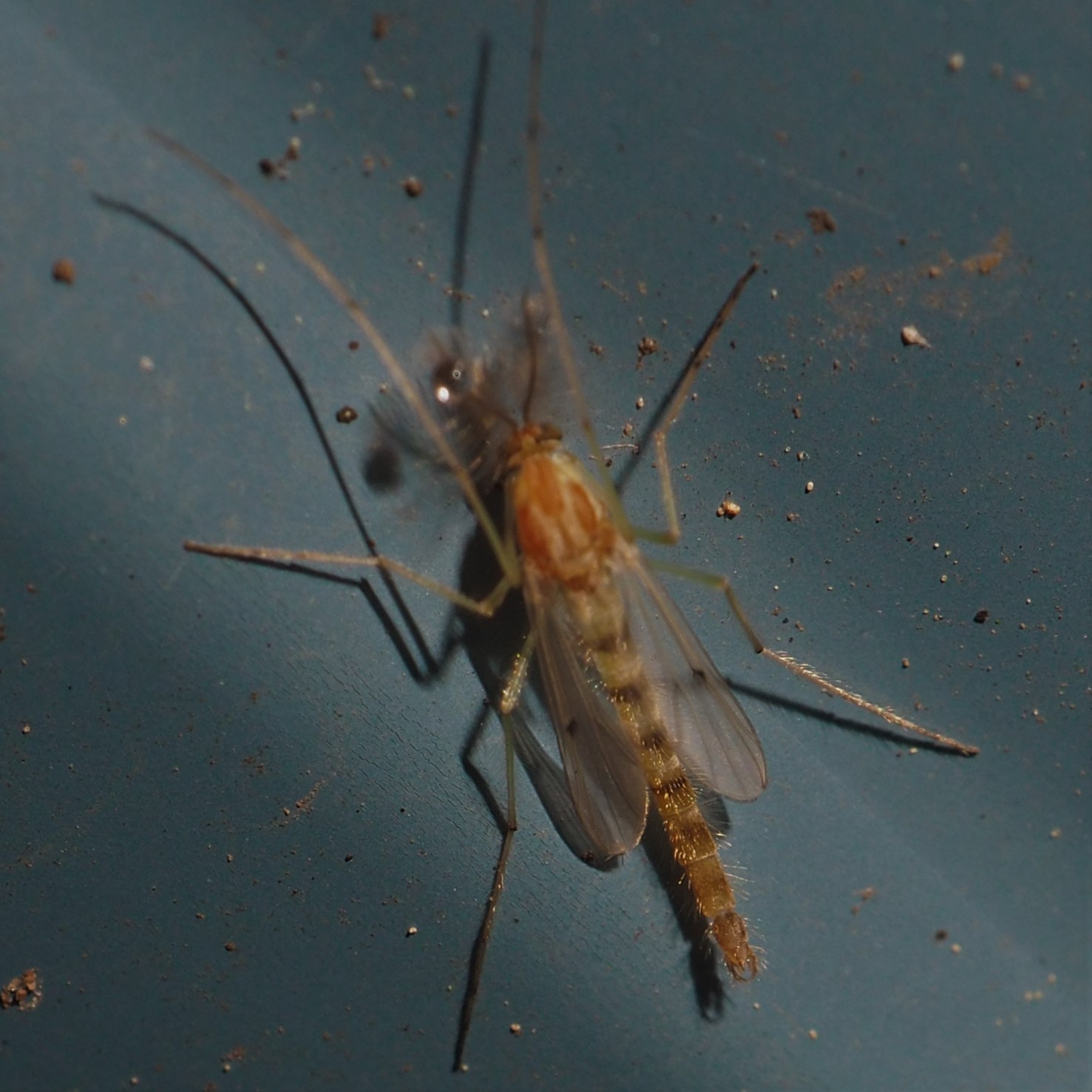
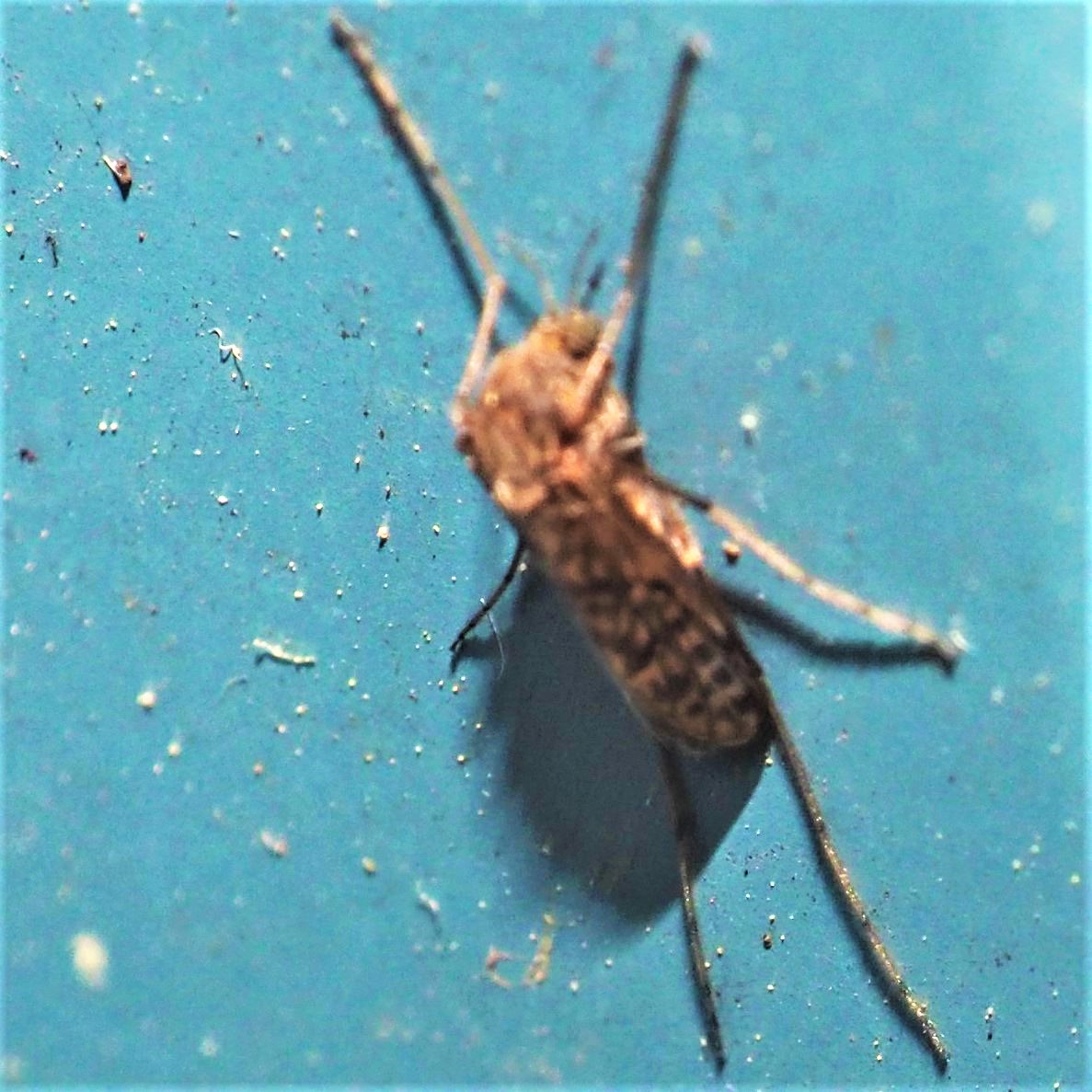
A couple of Moth Flies.
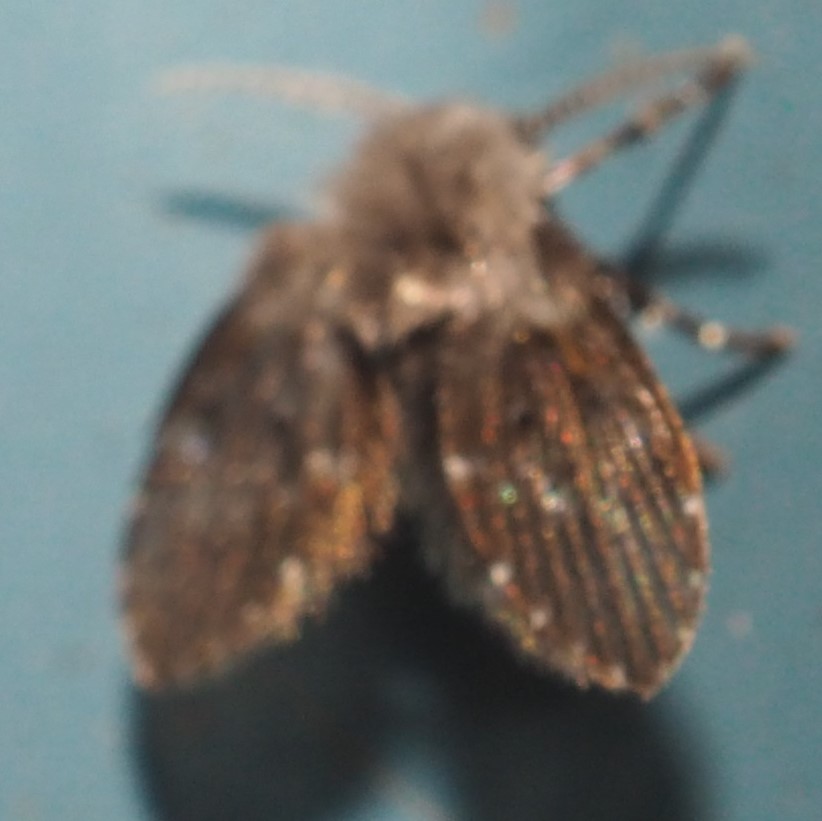

Here are two flies - numbers 1 and 2 imagine the first. Number 3 is the second, and what a face!
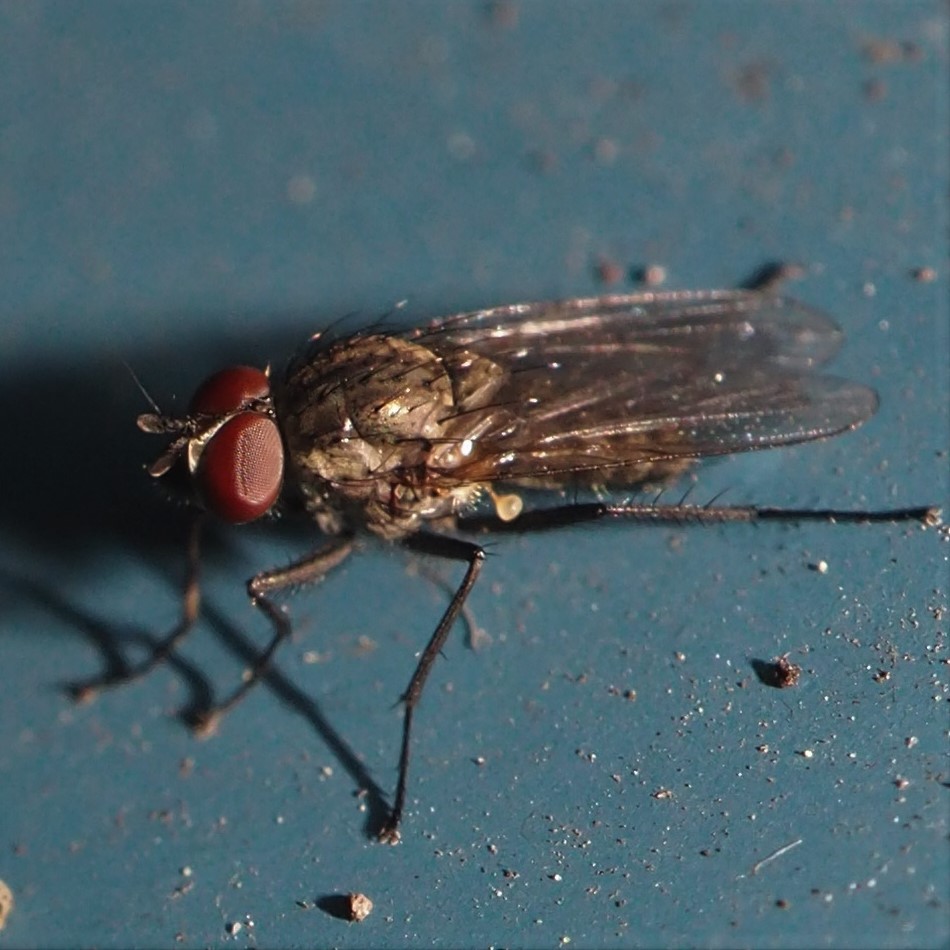
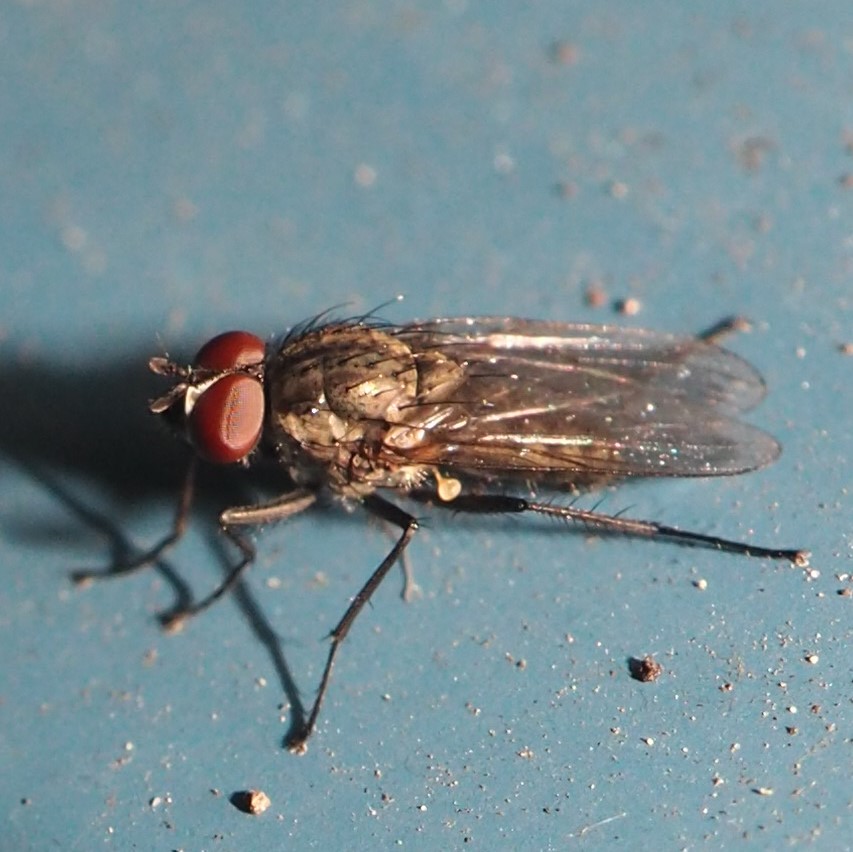
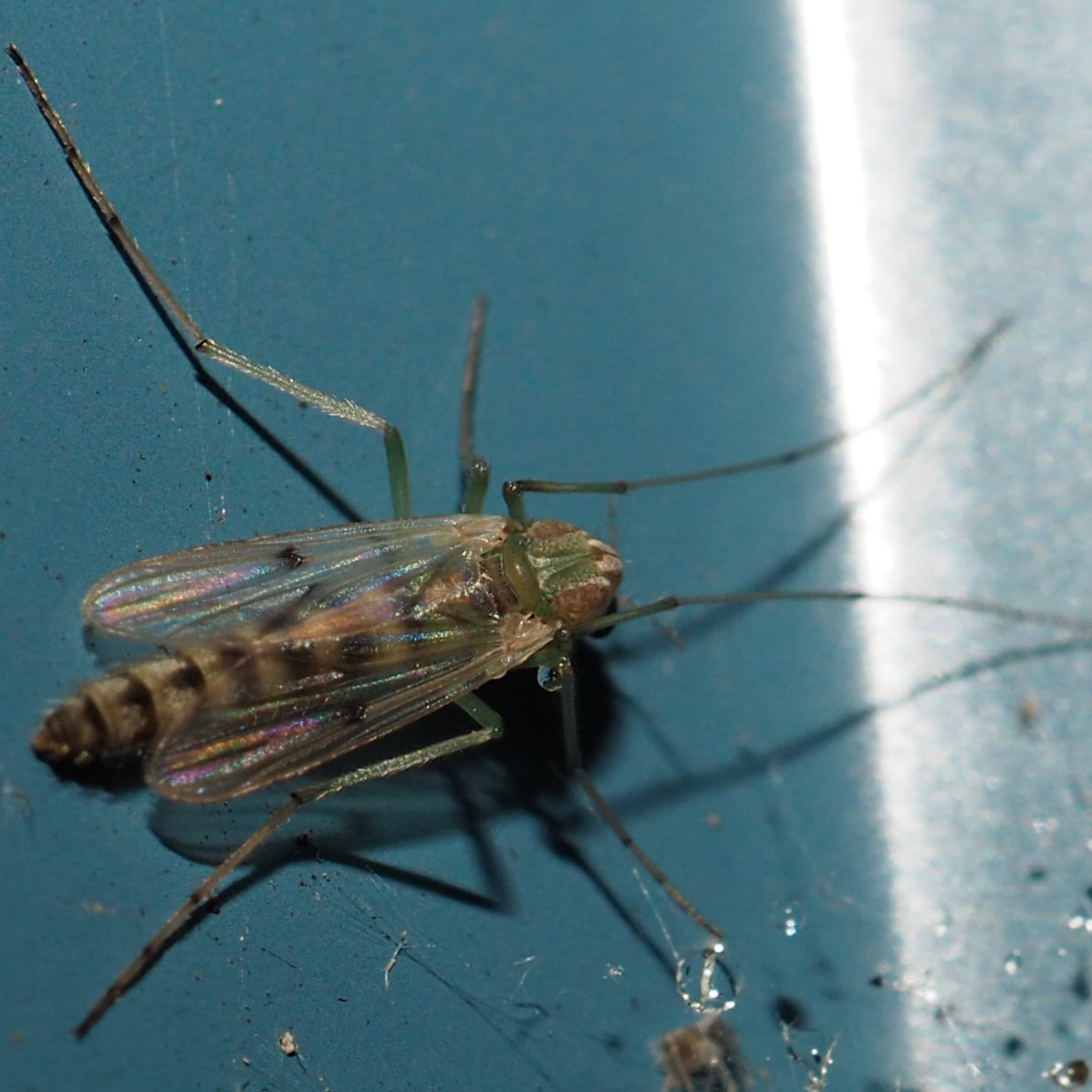
A Fly of genus Suillia (probably!). Number 3 always fools me. (It's a fly (Rainieria antennaepes), not a wasp!)

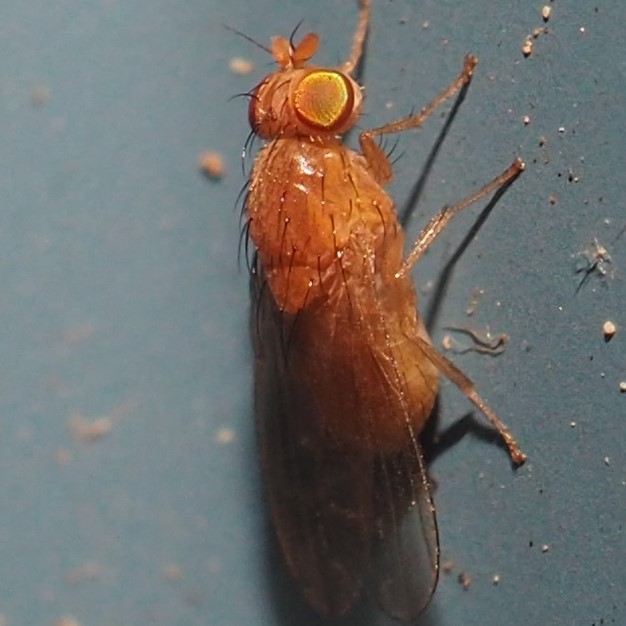
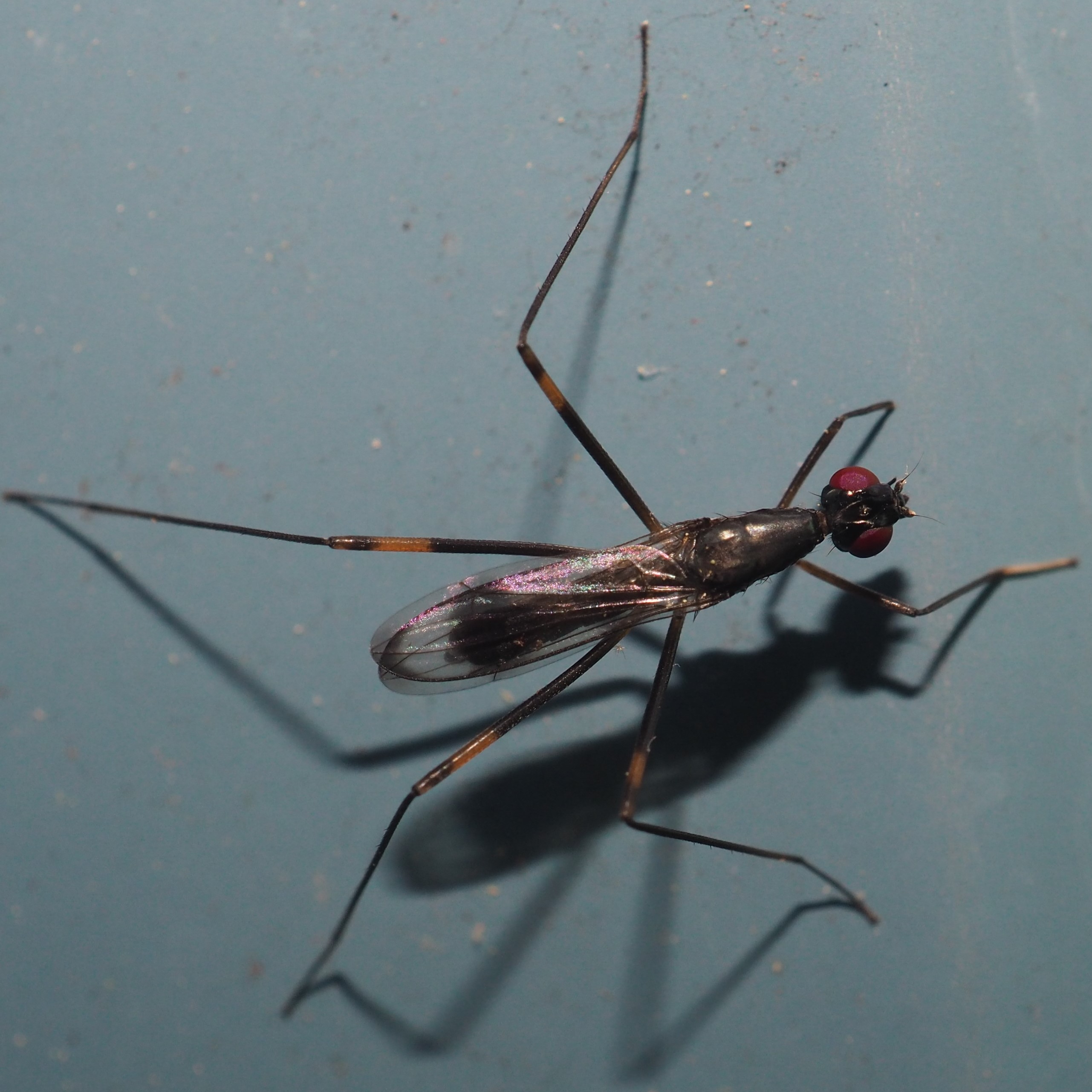
How about some Moths? My neighbor Deb sent this Tulip Tree Silk Moth from her sister Pam in Tennessee! This is one of the huge Saturniids, related to the Luna Moth and the Cecropia and Polyphemus too. So it's BIG! and beautiful. Second is such a little guy in comparison, the European Spruce Needleminer Moth (Epinotia nanana). And third is a member of Tribe Grapholitini, and hence a member of the Olethreutine Leafroller Moths. Actually, I should have said "two members of Tribe Grapholitini", as these little guys seem to be mating too. What a day for the Intimate Pictures Department!
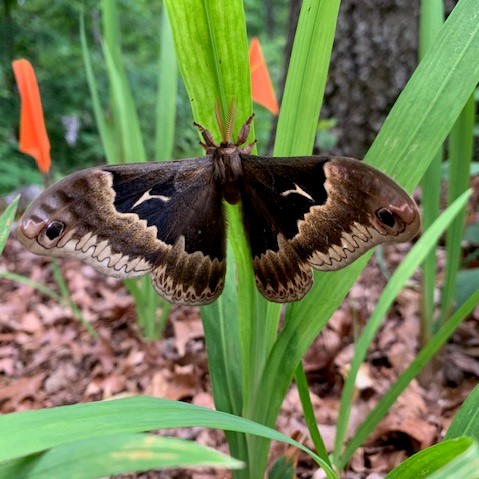
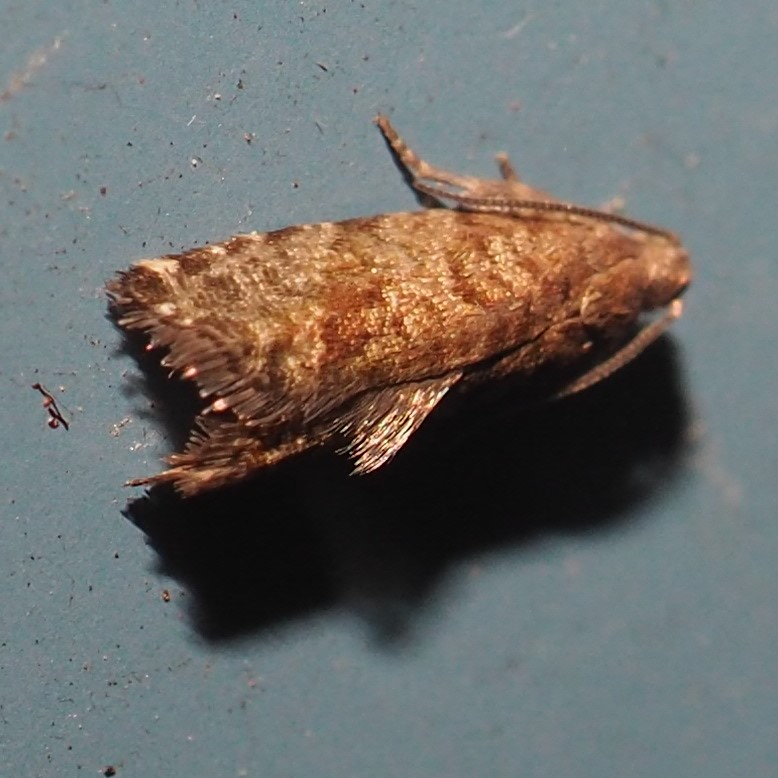

These next two are cousins, in that they are both Eye-cap Moths. First is a Norway Maple Eye-cap Moth, and the second is another kind. The third here is one of the Leaf-miner Moths, probably a member of the Genus Phyllonorycter (we've now seen a few members of this genus.). The fourth one just showed up while I'm writing the blog.

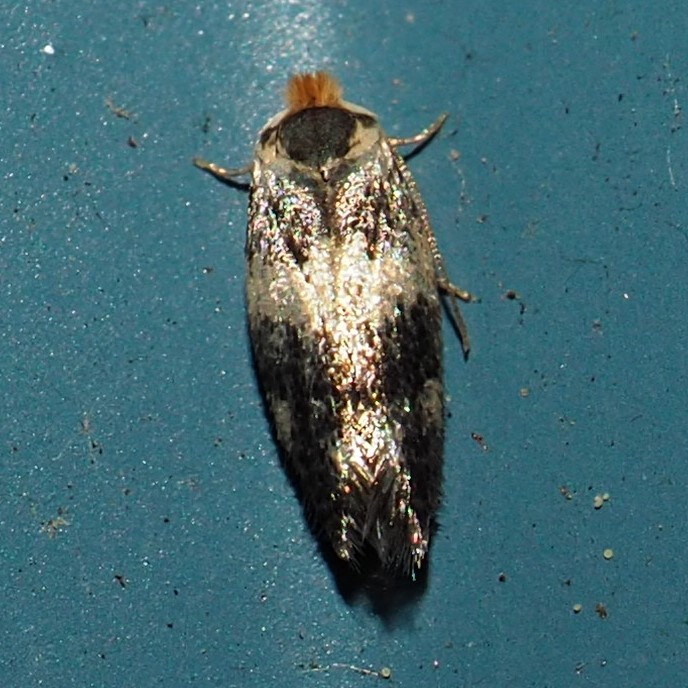
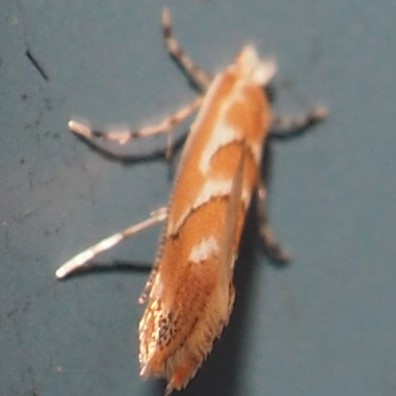
Here is one more Moth that just showed up. Next is Peck's Skipper, a lovely little fellow that was hiding in a little branch in the side yard.
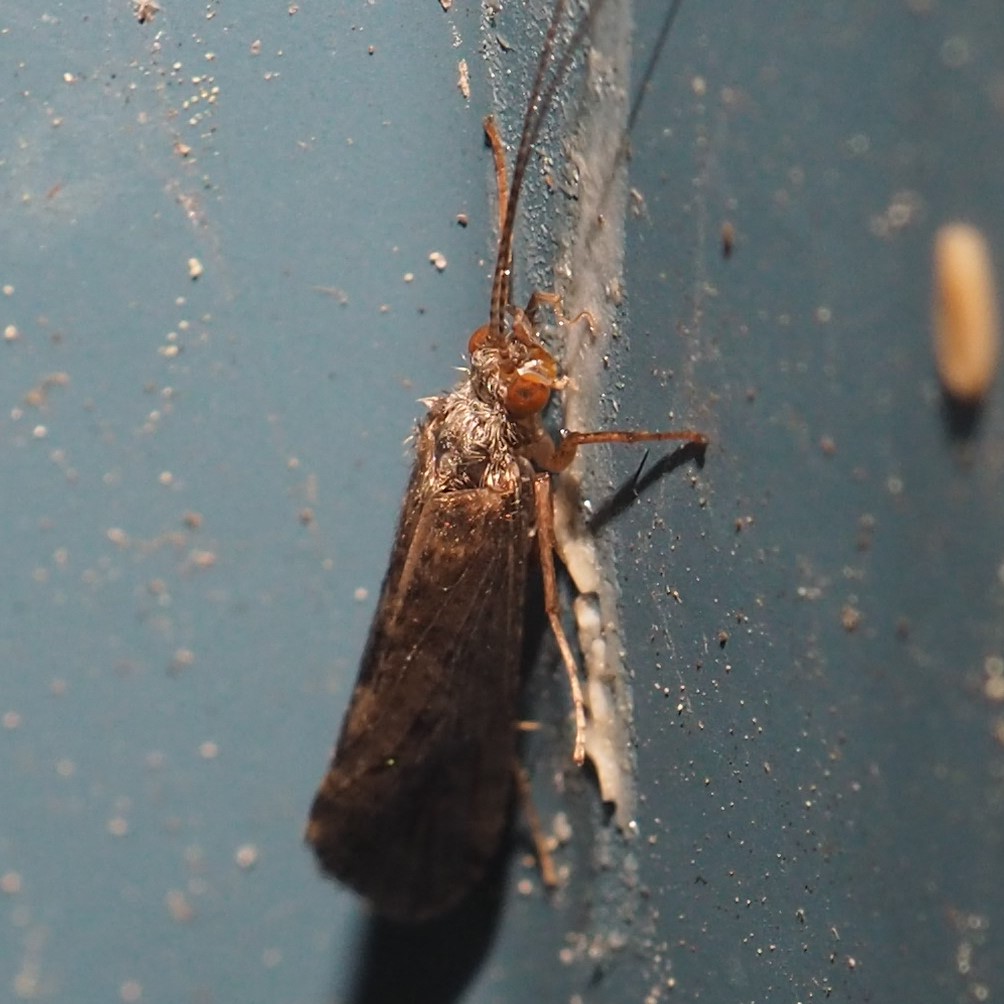
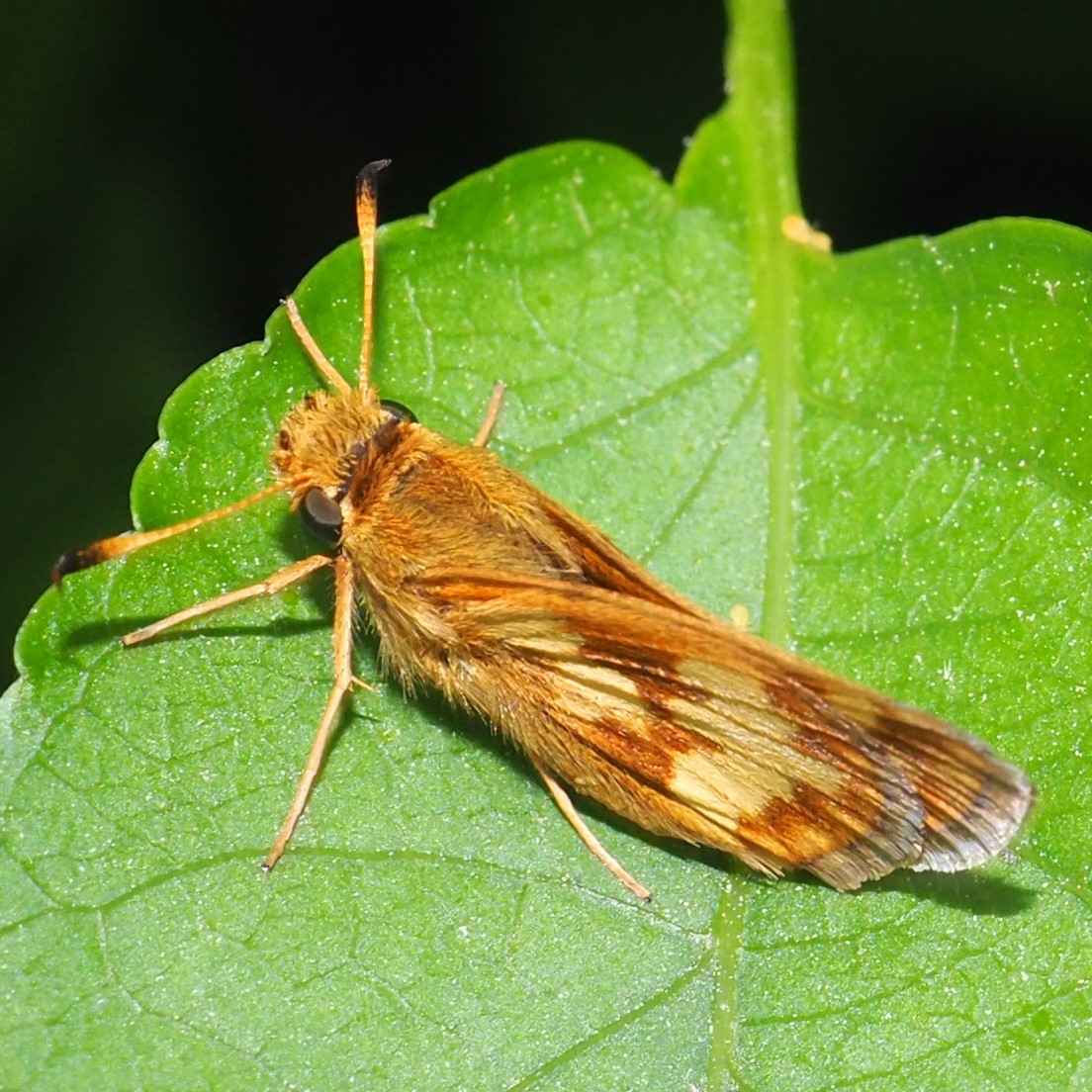
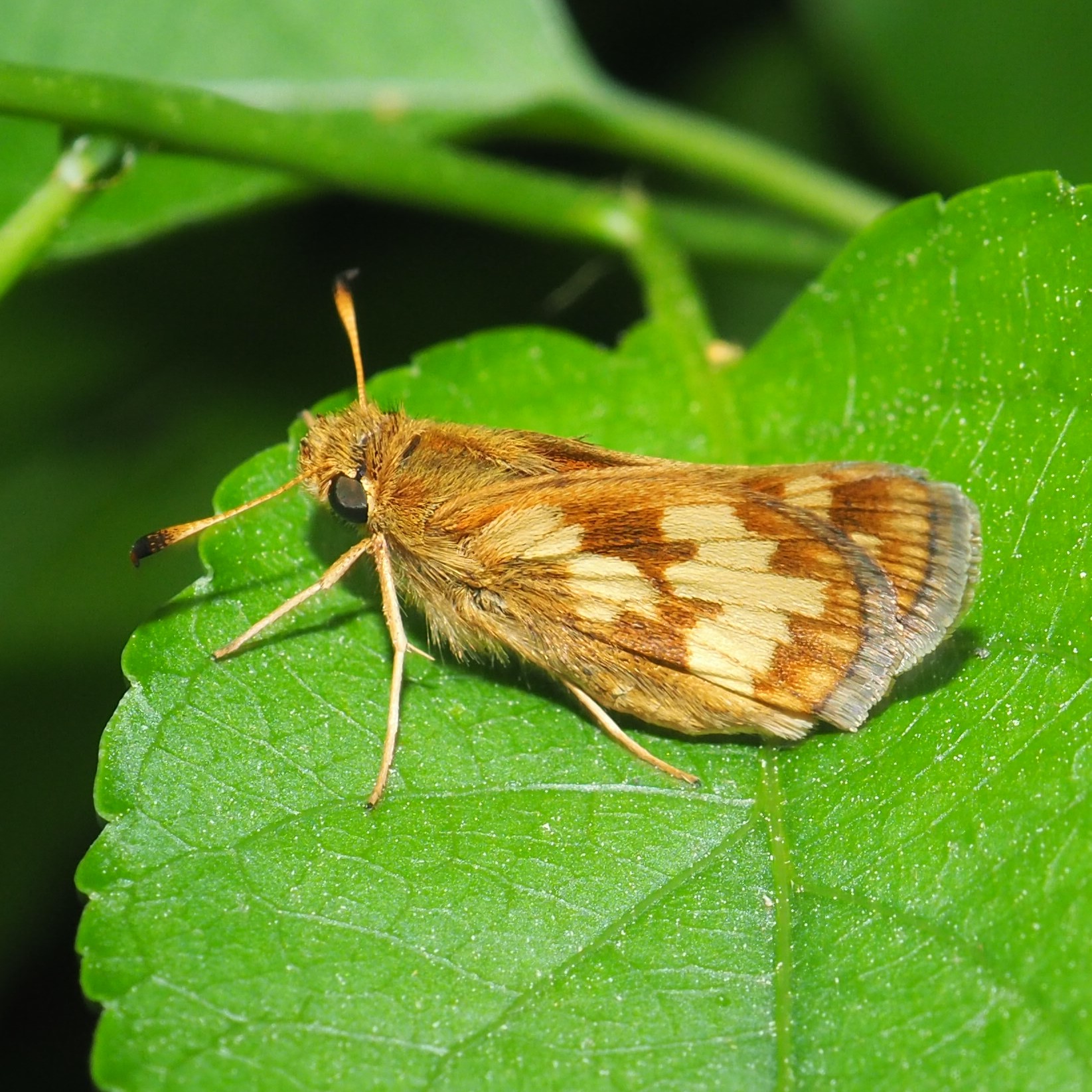
Let's walk through the flowers for a while. Here's that Cranesbill Geranium, right, a real Geranium. Next to the driveway, where surprising things come up, a White-flowered Wild Rose or Wild Blackberry is flowering. The now-famous Dame's Rocket is still blooming too. I'm so glad someone let their pet weeds spread to my yard!
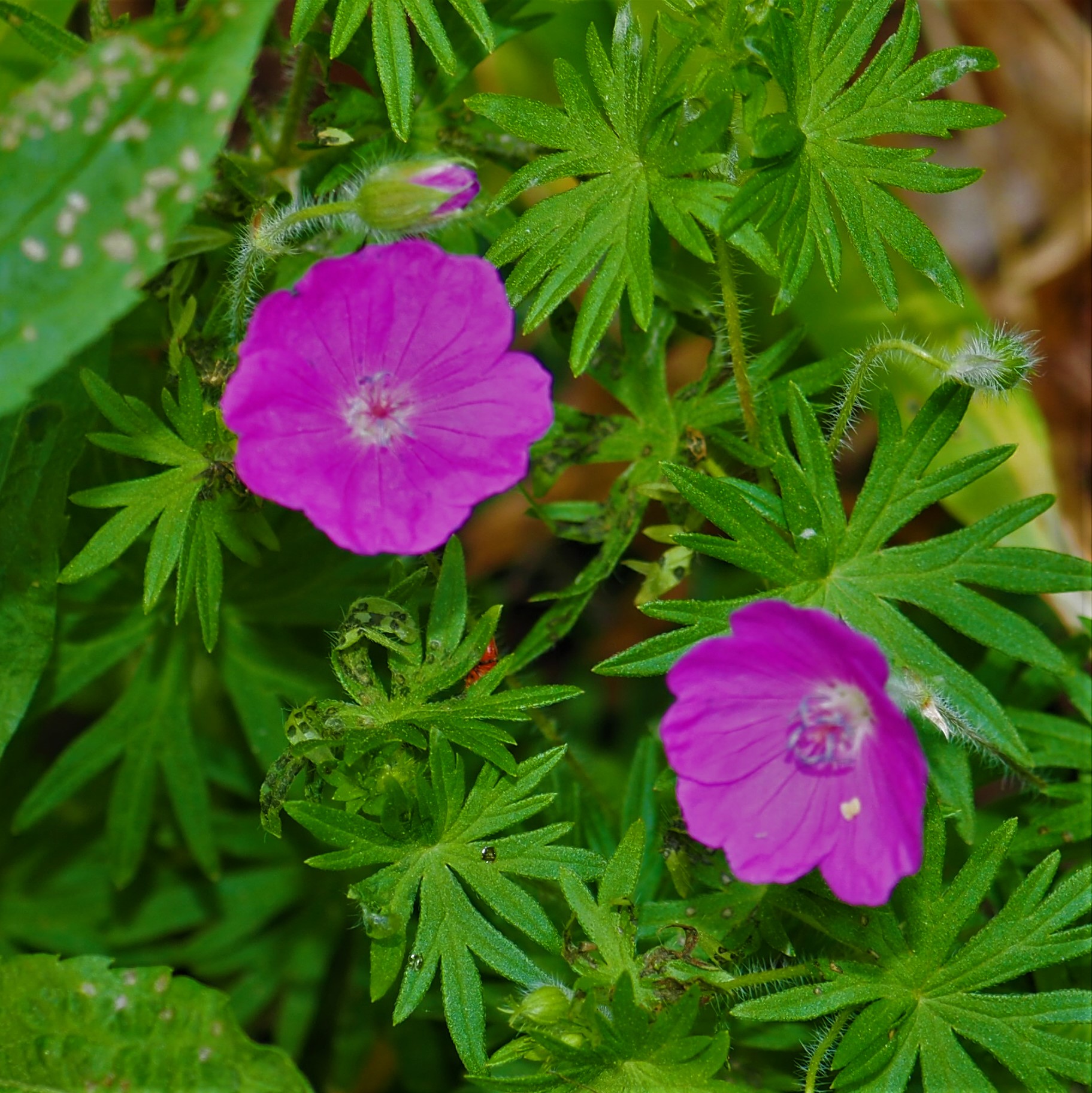


The Double Pink Columbine is glorious for a week or two, also by the driveway. So is its relative, the Red and White Columbine. Finally, this columbine plant is being mined by two kinds of leaf miner insects.
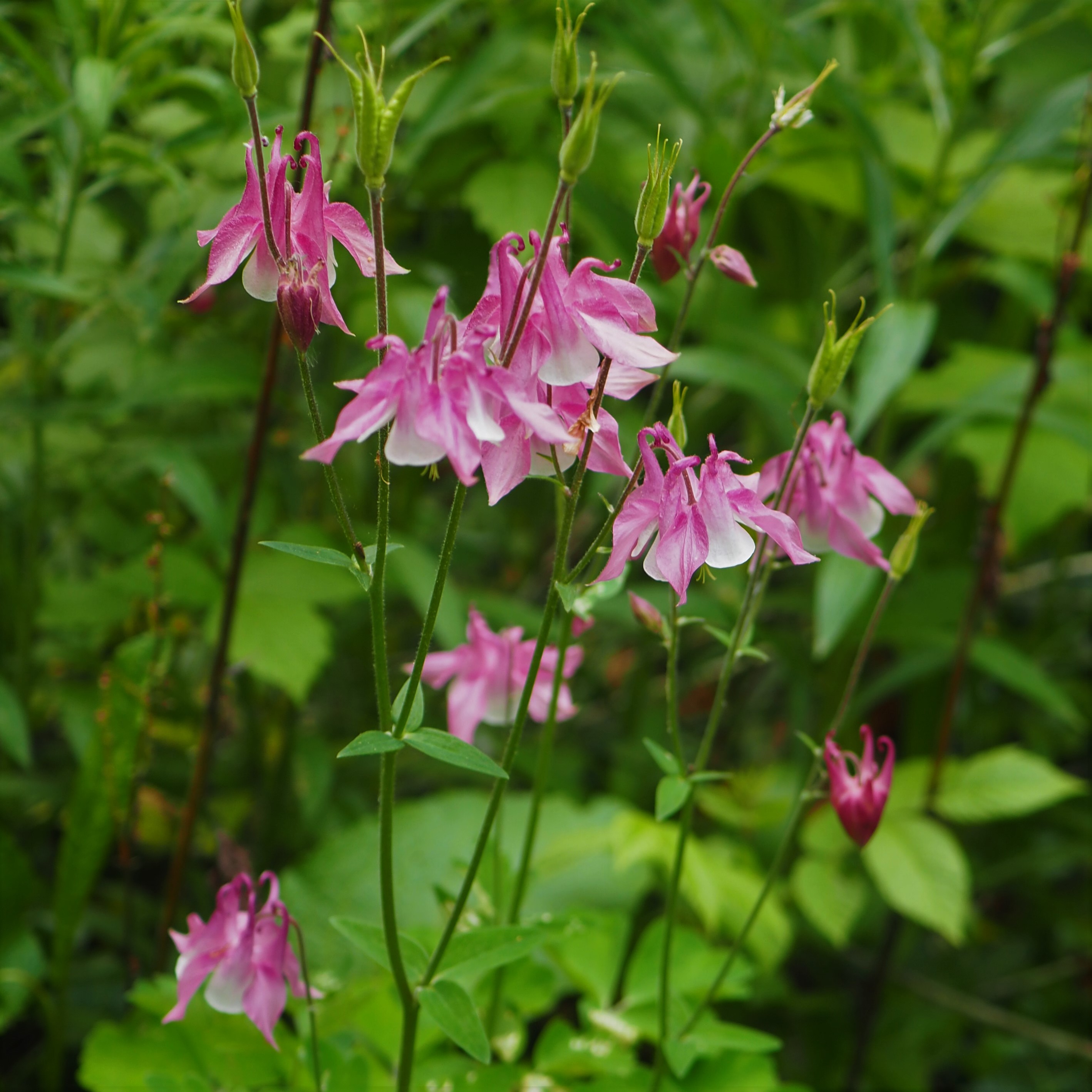
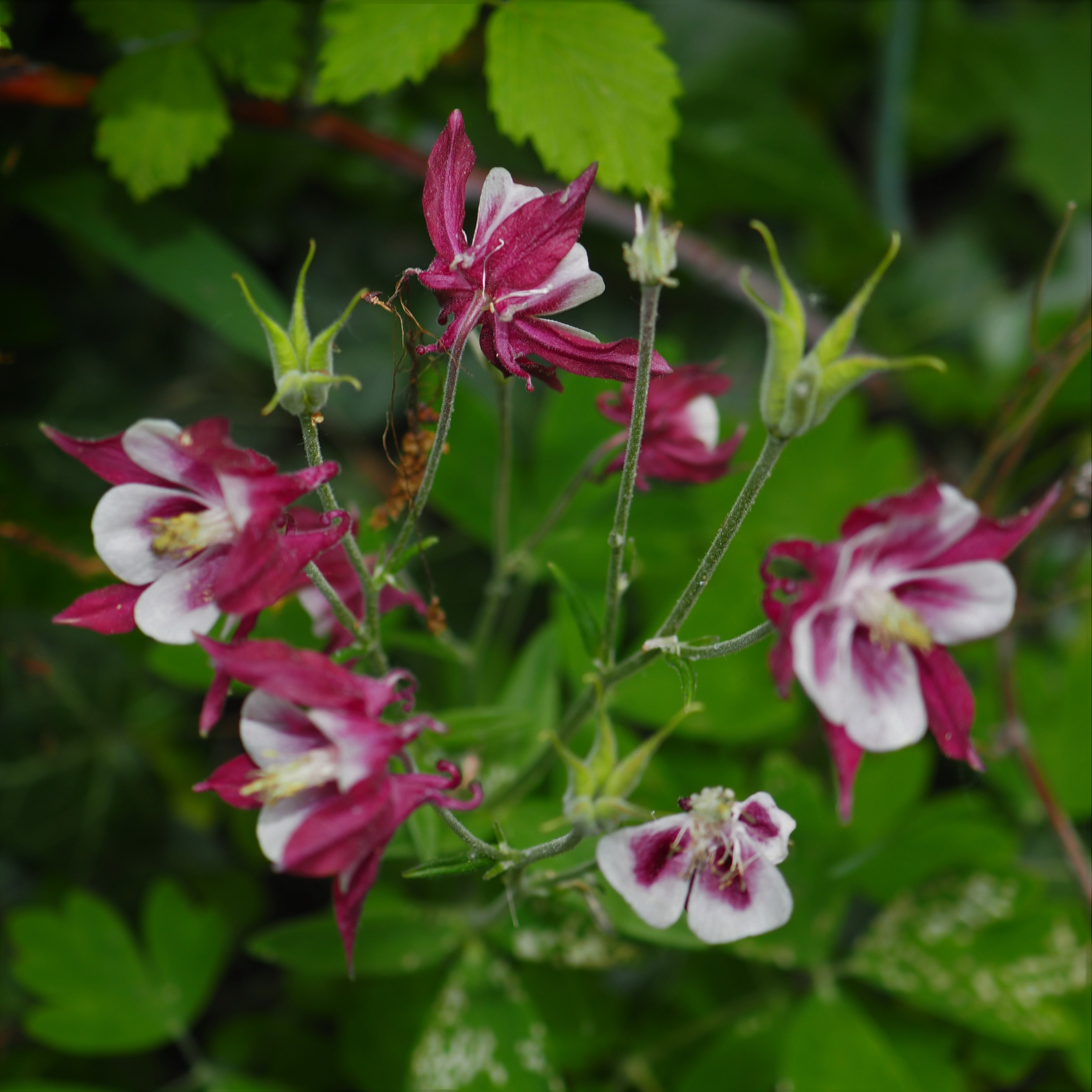
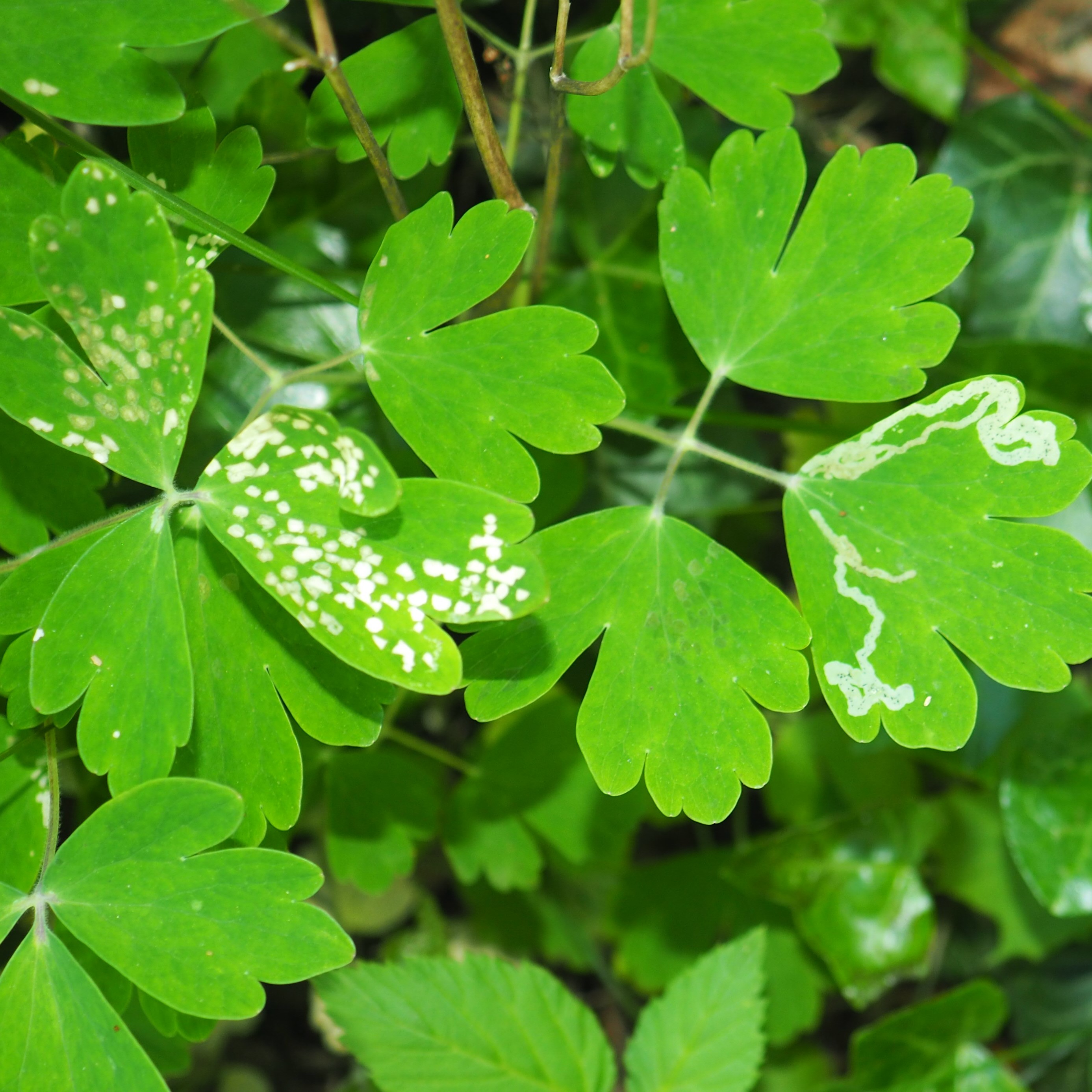
Here's the batch of Dame's Rocket on which we found the Weevils. I picked a flower head at random and sure enough - there's a Weevil right there (picture 2)! It worked on another flower head but I stopped before disturbing any more of our pet Weevils!



Here is some Yellow Hawkweed. It comes in yellow and red-orange, as I recall, but I don't have the redder version. Remember that Hellebore whose flowers we watched rise above the old leaves? Well, now the new leaves hang down way above the blossoms. I know, I know, I already used this picture of a Bee in the Goutweed, but since it is the start of the Goutweed season, I figure we need to show it again.
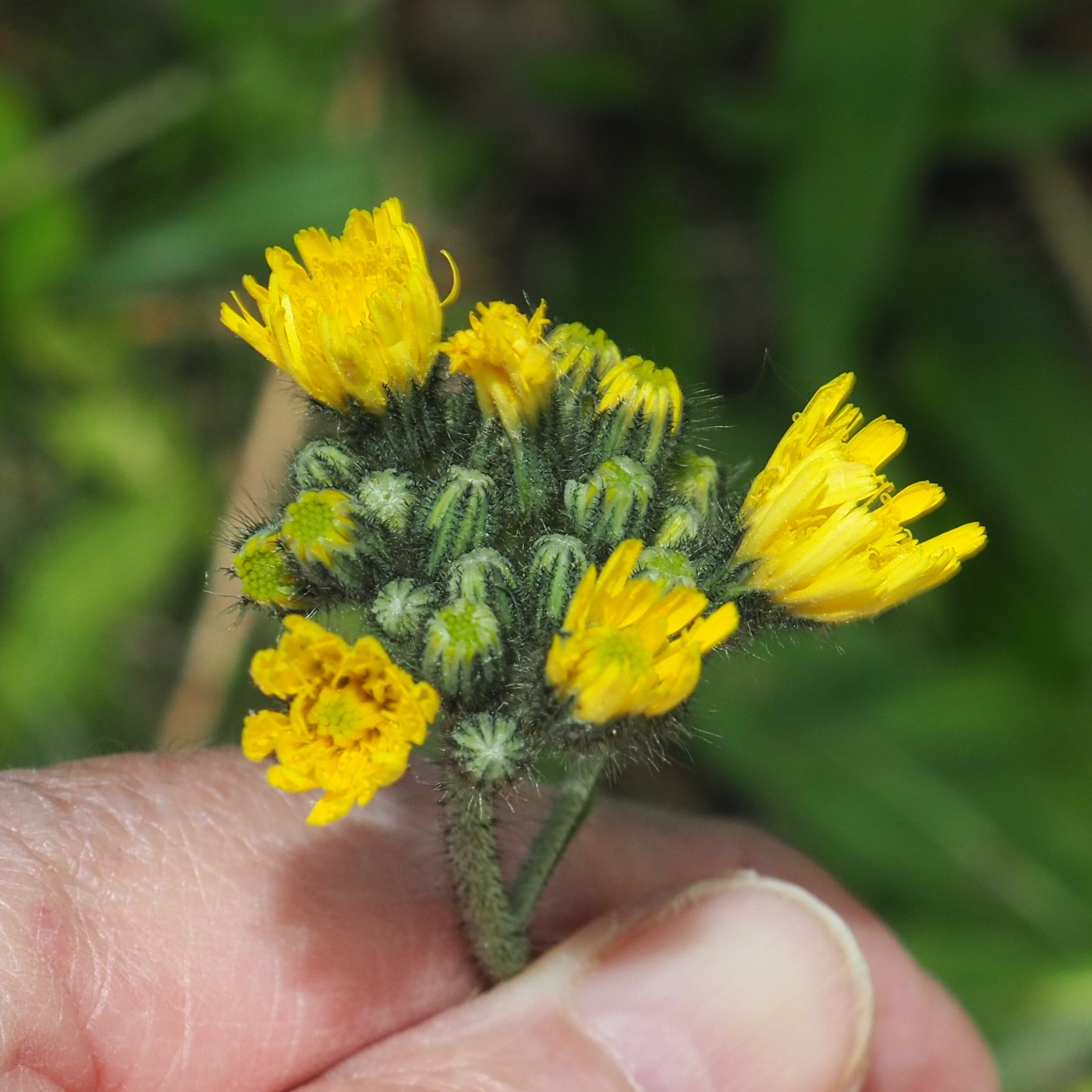
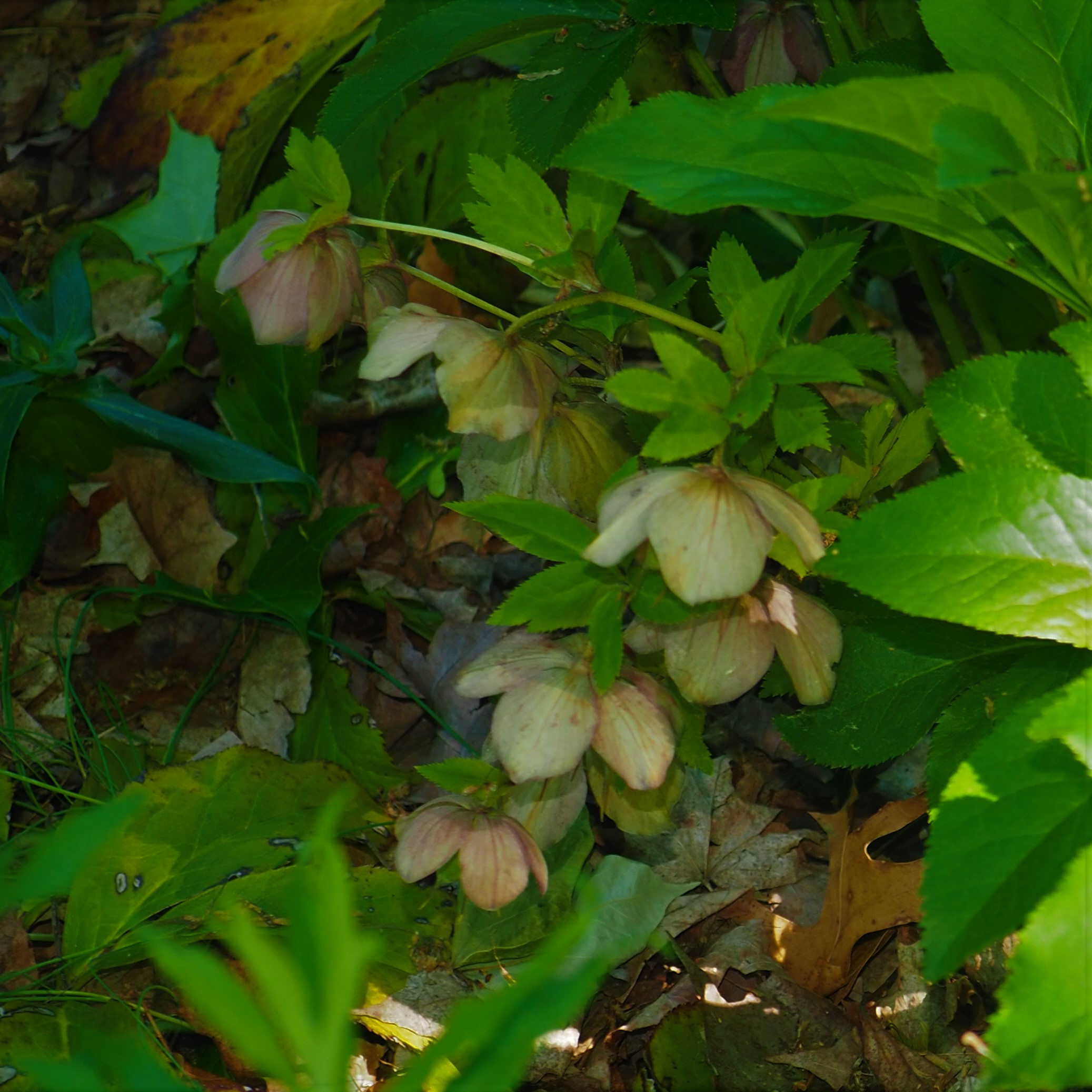

That's about the end of our Flower Stroll, so let's see what kind of Spiders we had this week. Many tiny and growing Cobweb Spiders. I only got one picture of this black Spider with red legs. And last is another mystery Spider.
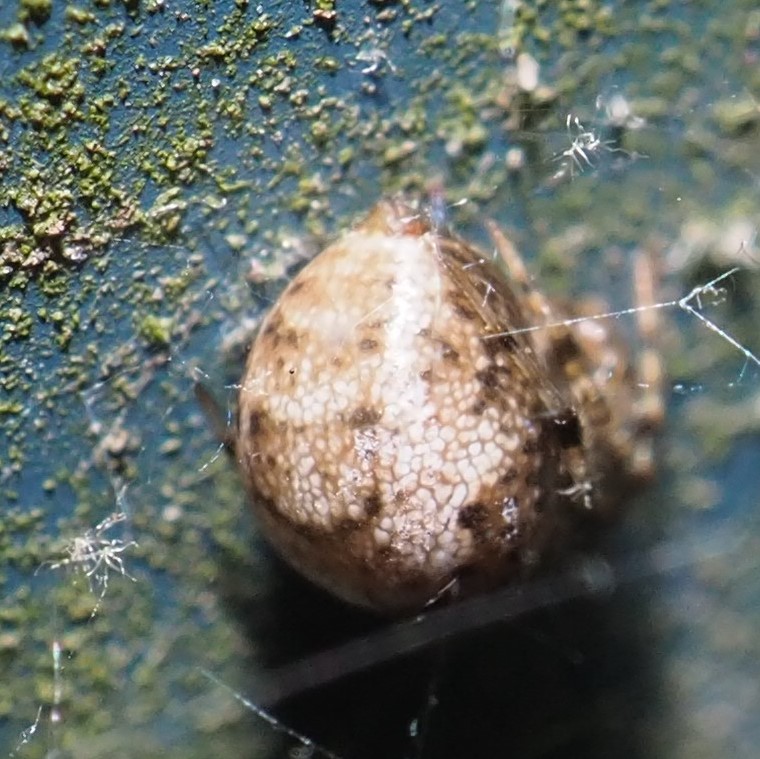
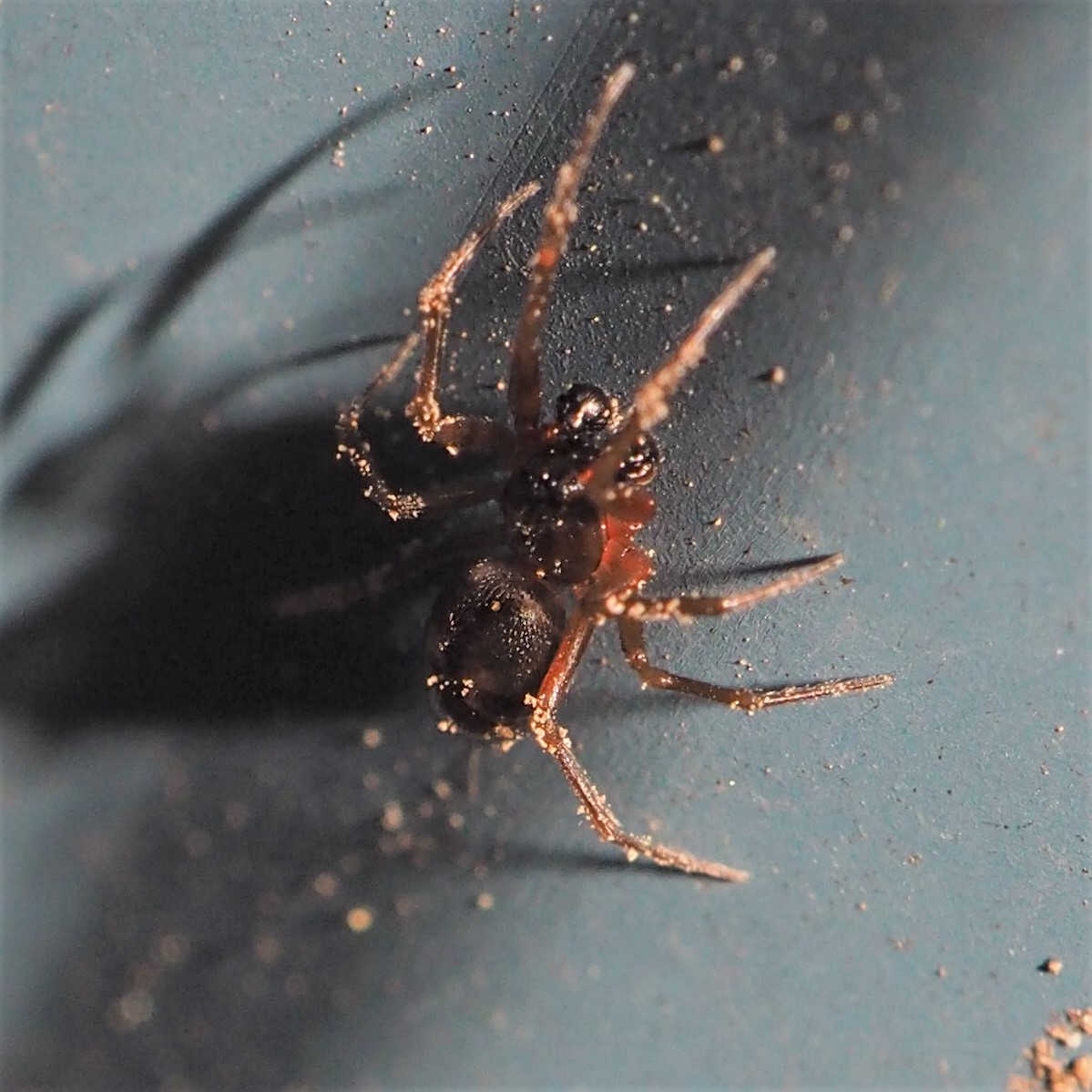
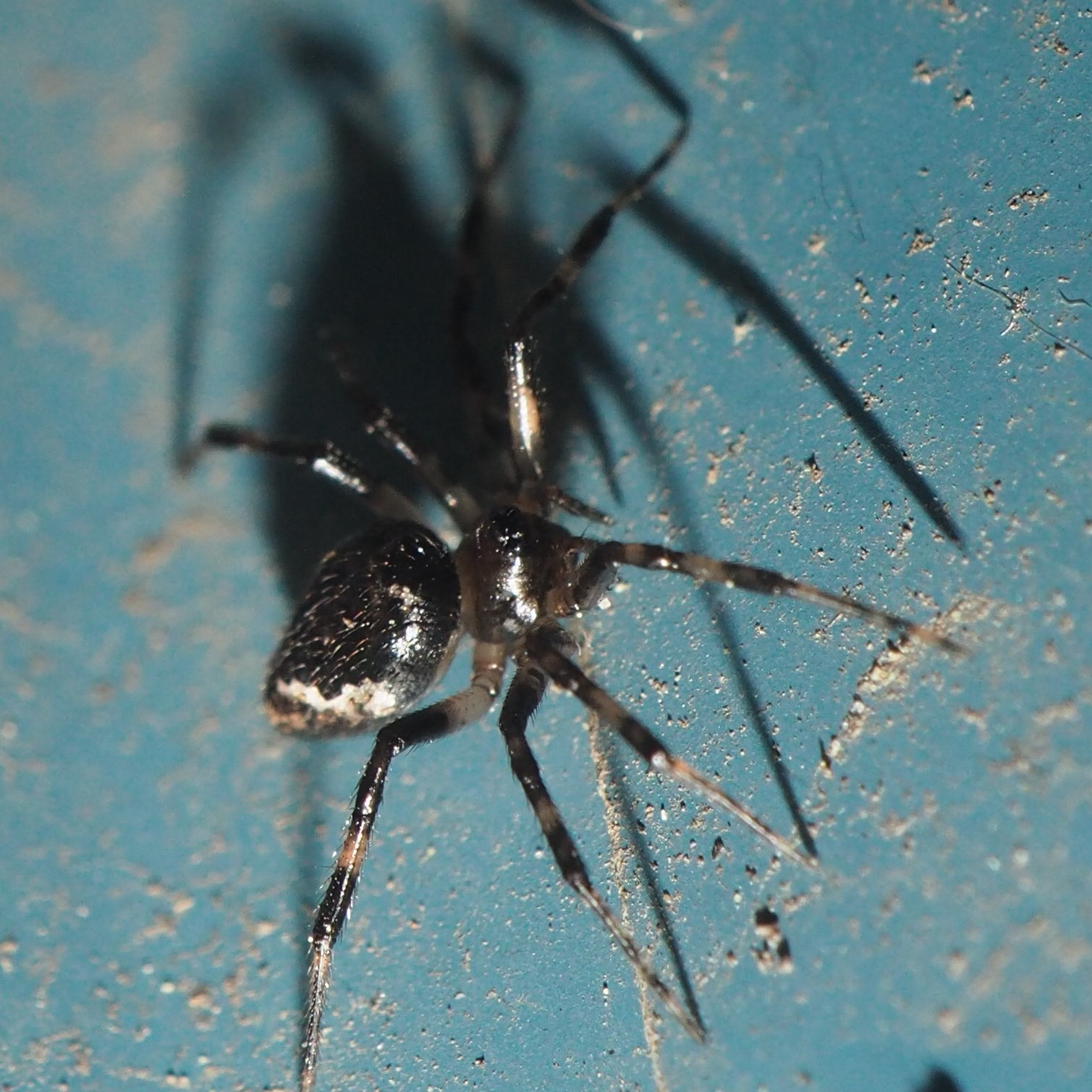
We had a few large Crab Spiders. The Bassaniana is one of them. Second is another kind of large Crab.
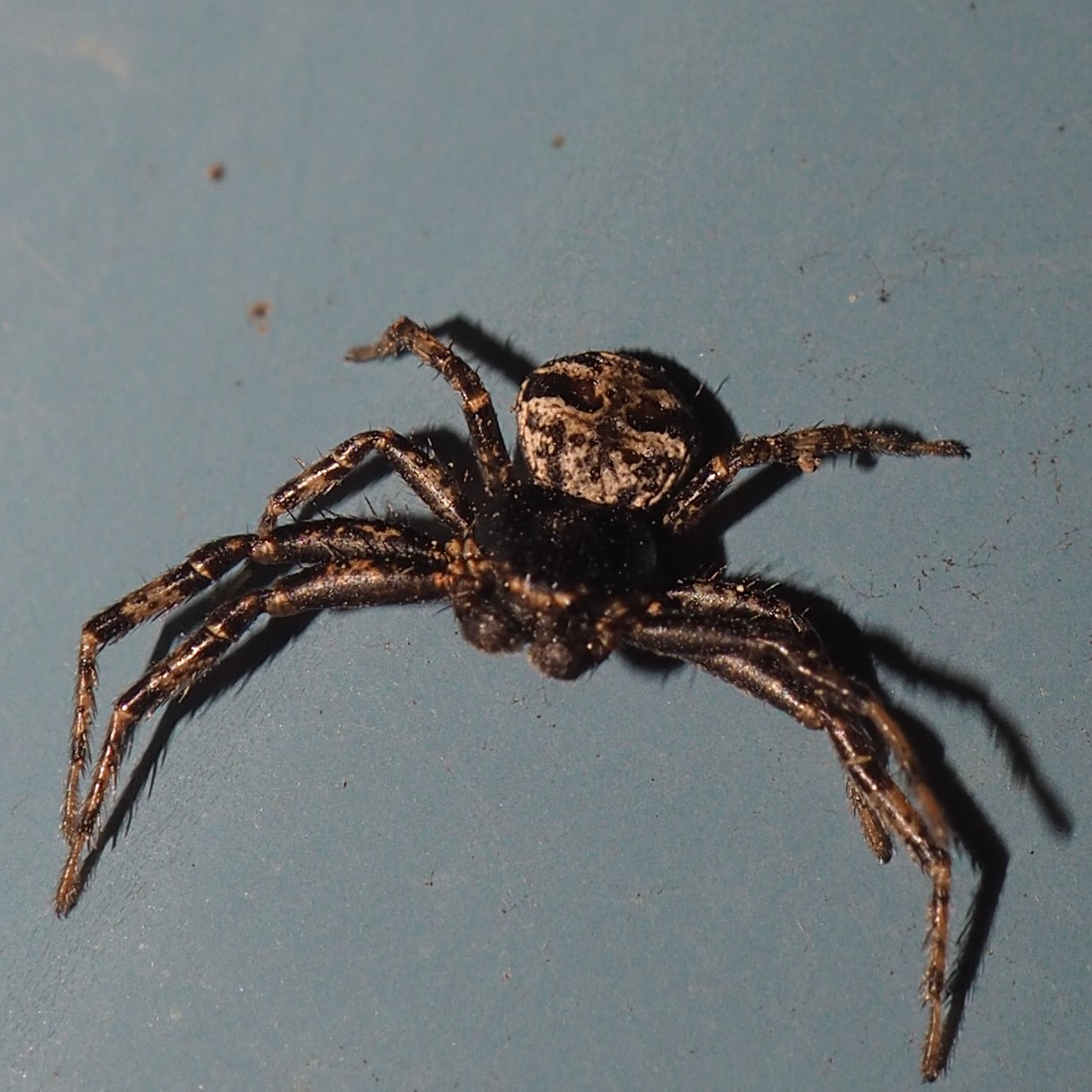
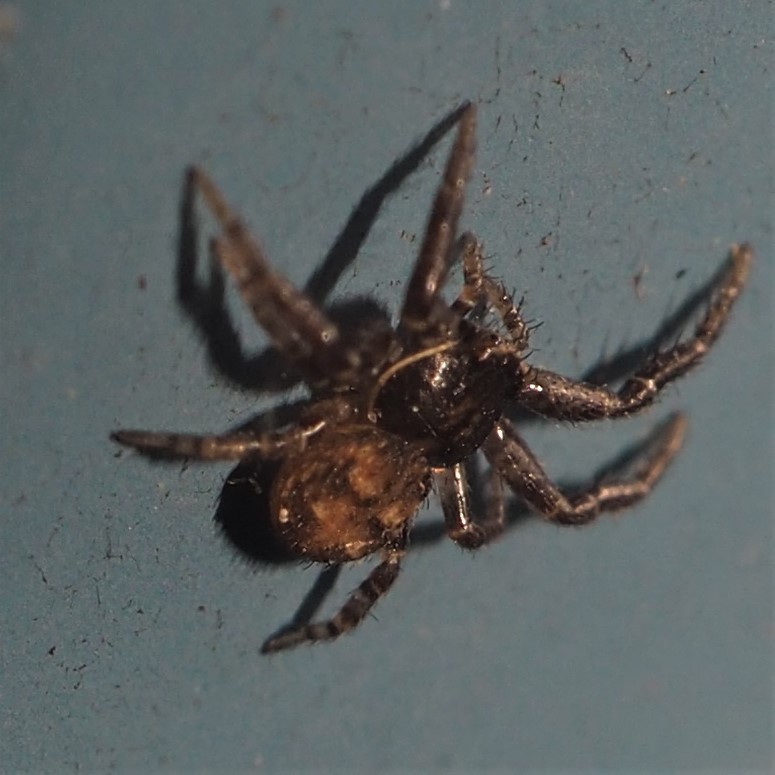
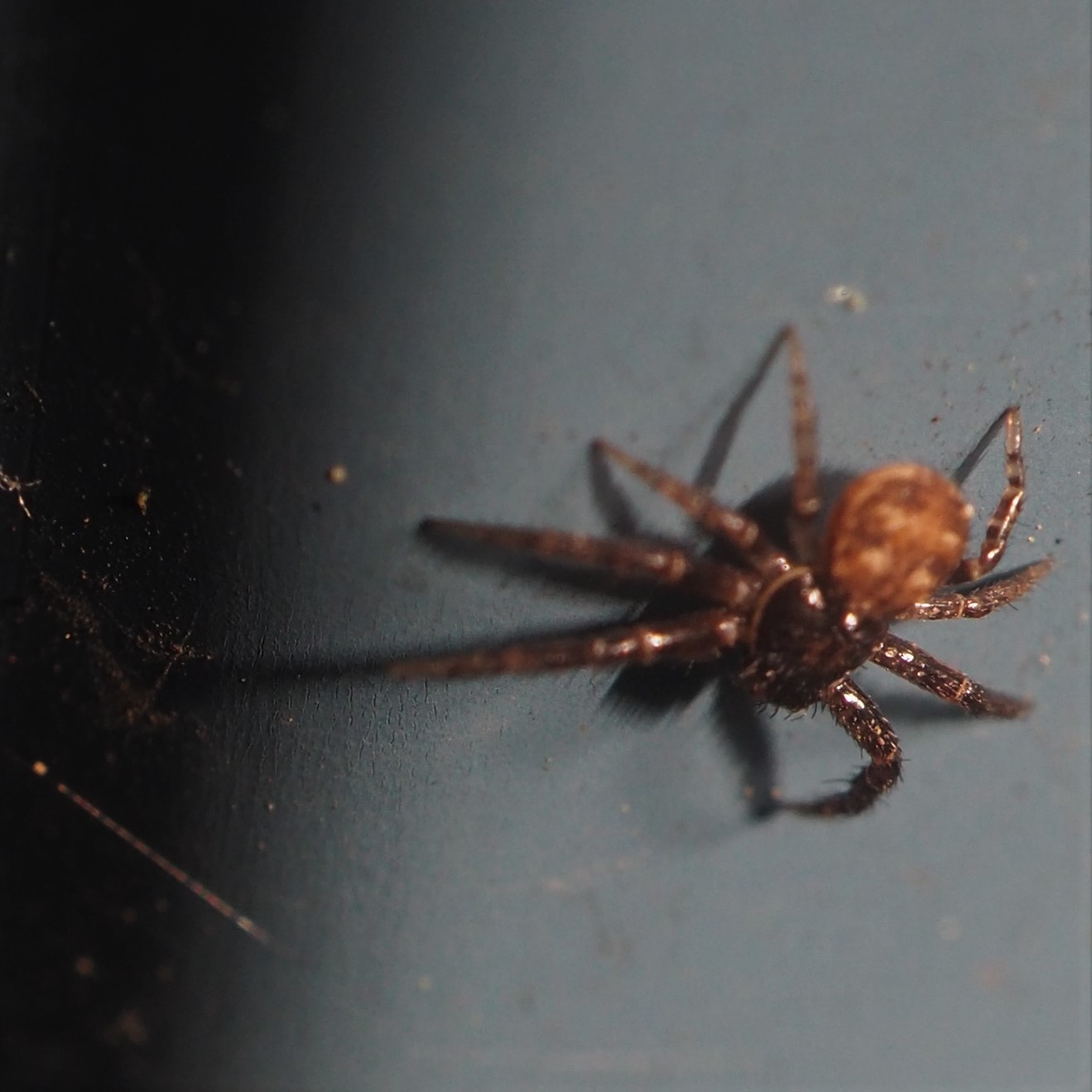
Here is Euryopsis funebris again. Interesting Spider! Then a new (to me) Jumping Spider. Picture 3 shows its headlight eyes. But the abdomen in picture 2 LOOKS as if it shows a face - it isn't a real face but it always makes me look anyway.
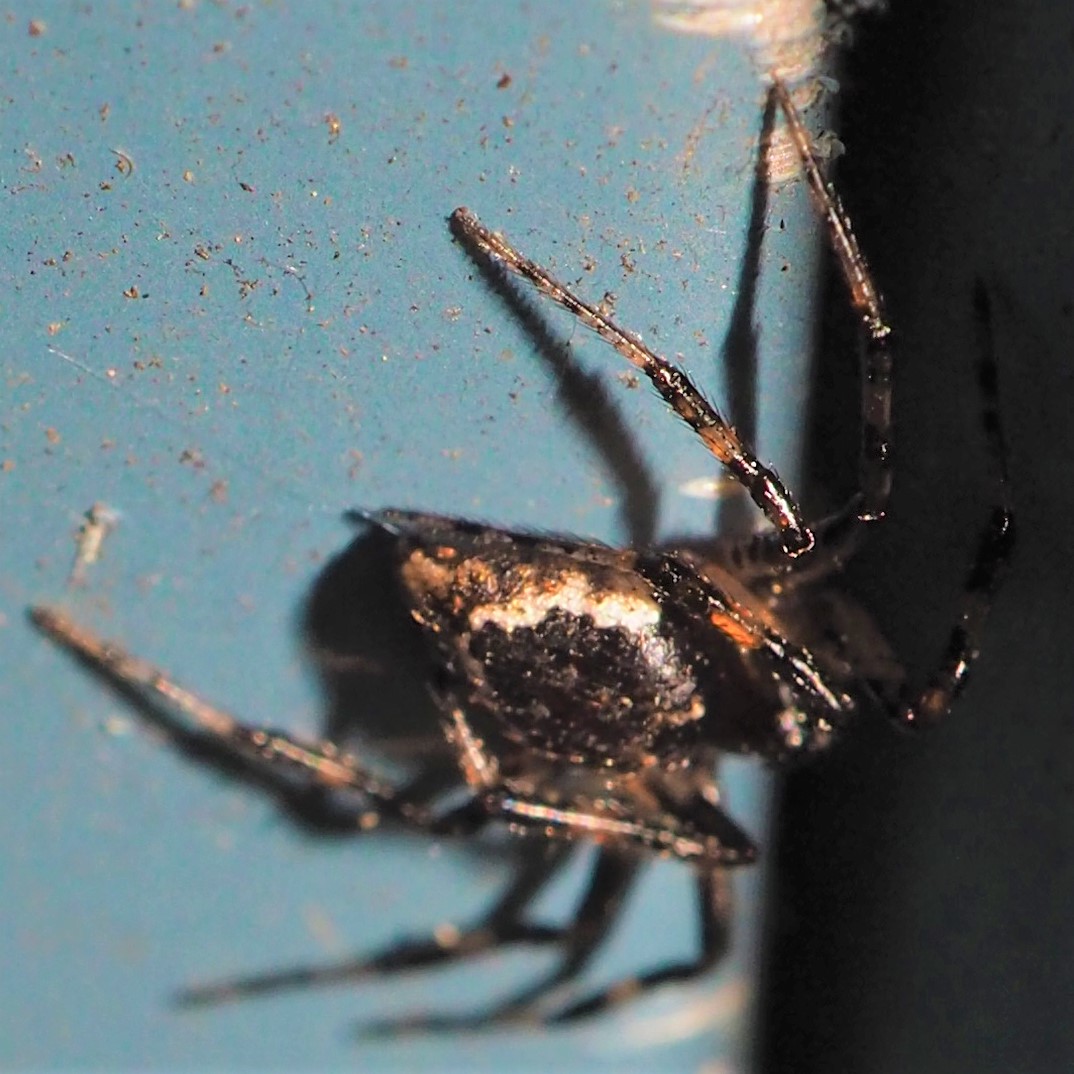
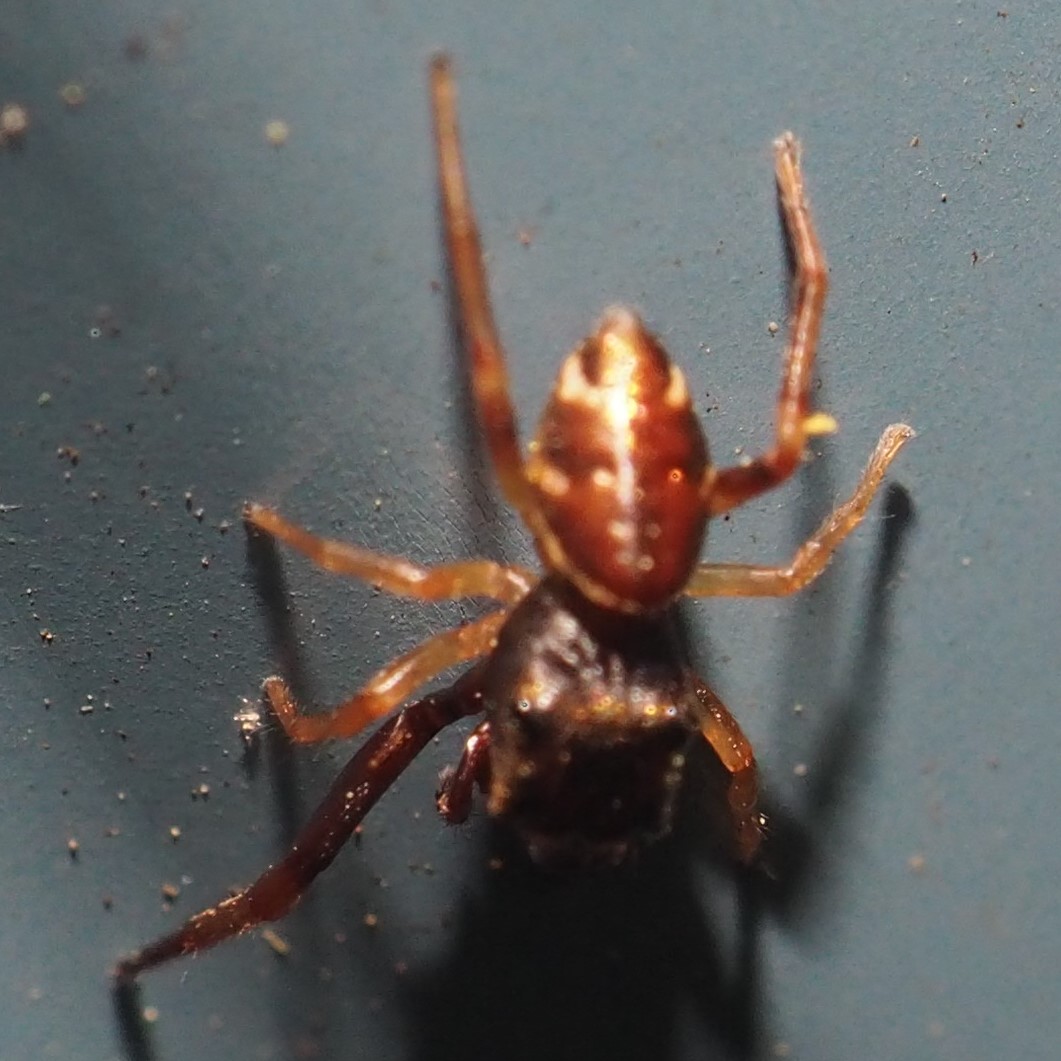
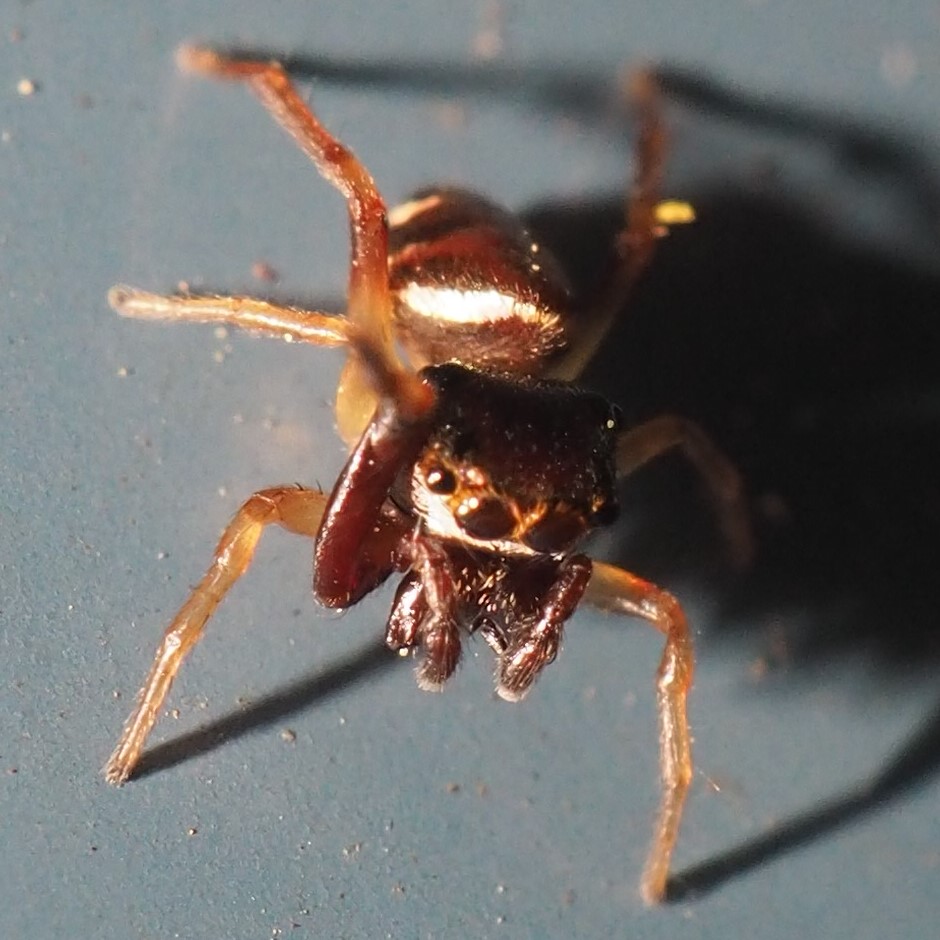
I don't usually expect Springtails in May, but we had one long Slender Springtail (picture 1) and one of the world's cutest critters, one Globular Springtail.
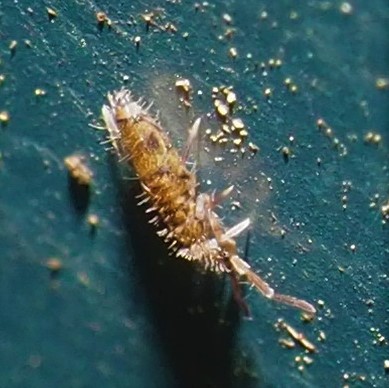
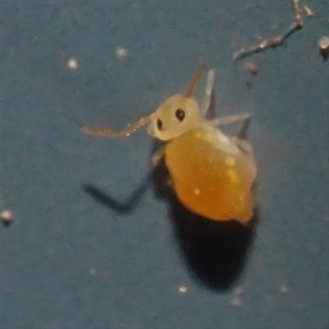
On May 27, a pair of American Toads came for a honeymoon. In picture 2, you can see the two-stranded eggs as they are being laid. Today, May 29, you can see the tiny Tadpoles which will grow into American Toads. They will grow under water and then in a few weeks when their tails have shrunk and their legs grown, they will climb out of the pond and generally disappear, although I will be in danger of stepping on one of the tiny baby
Toads for some time.
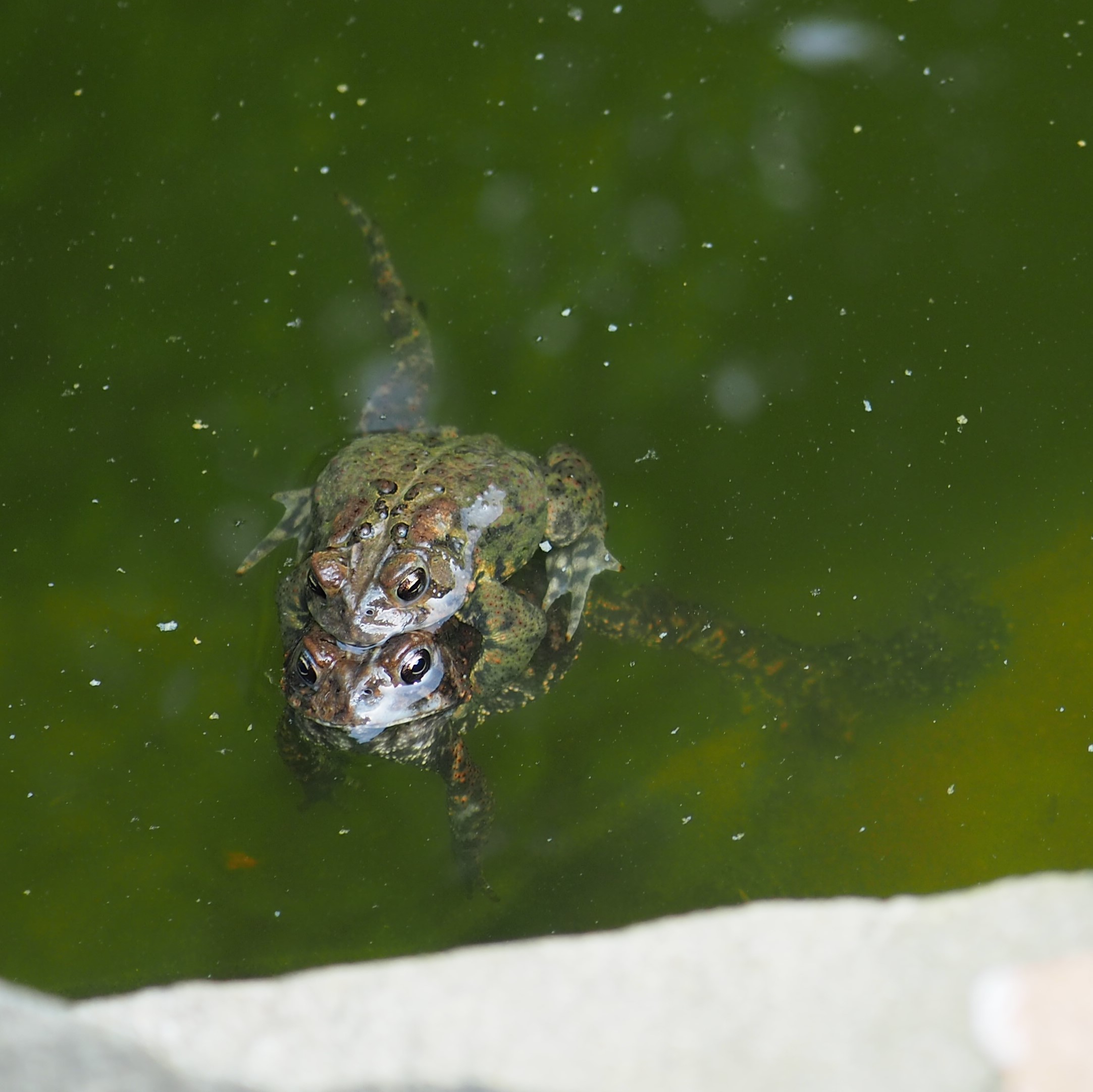
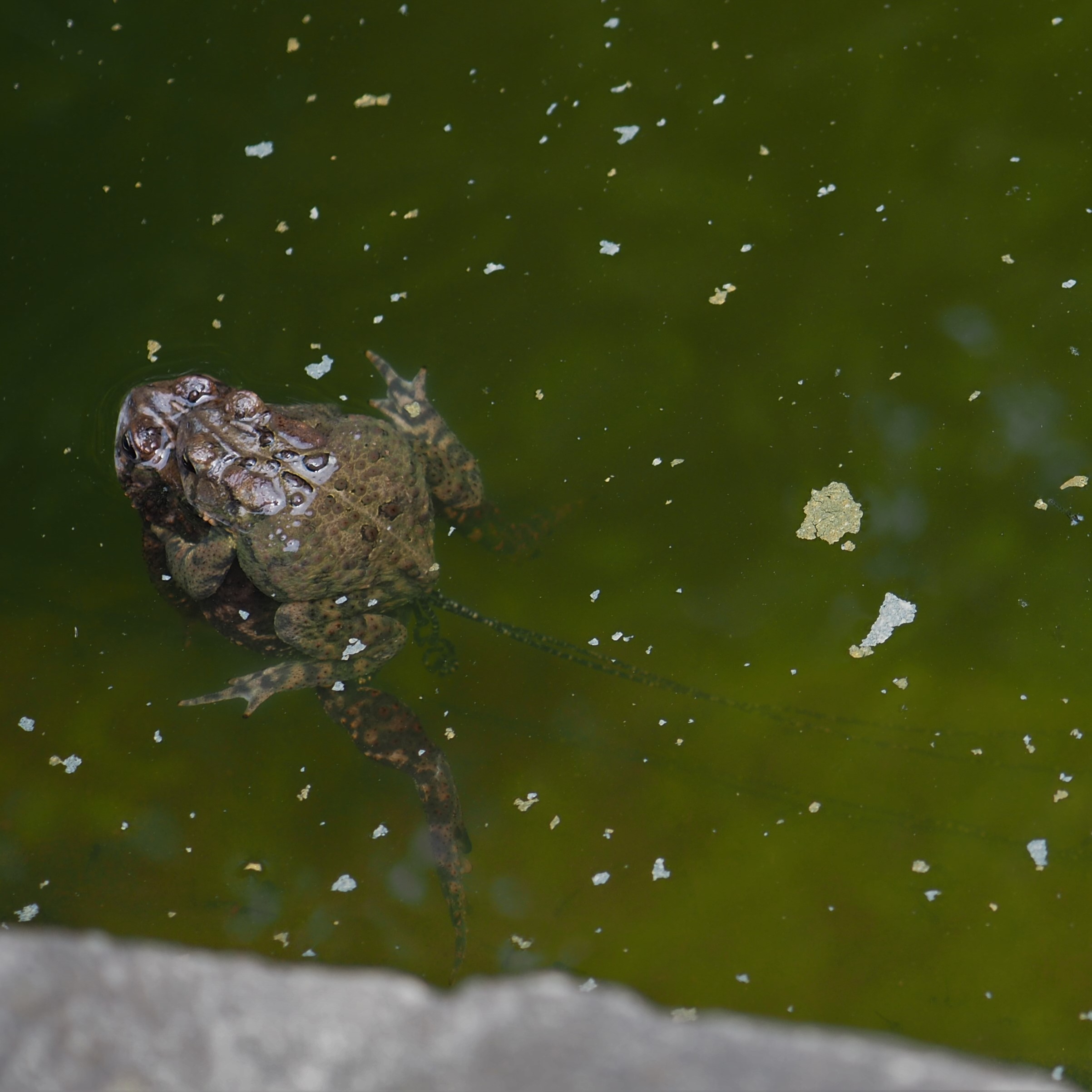
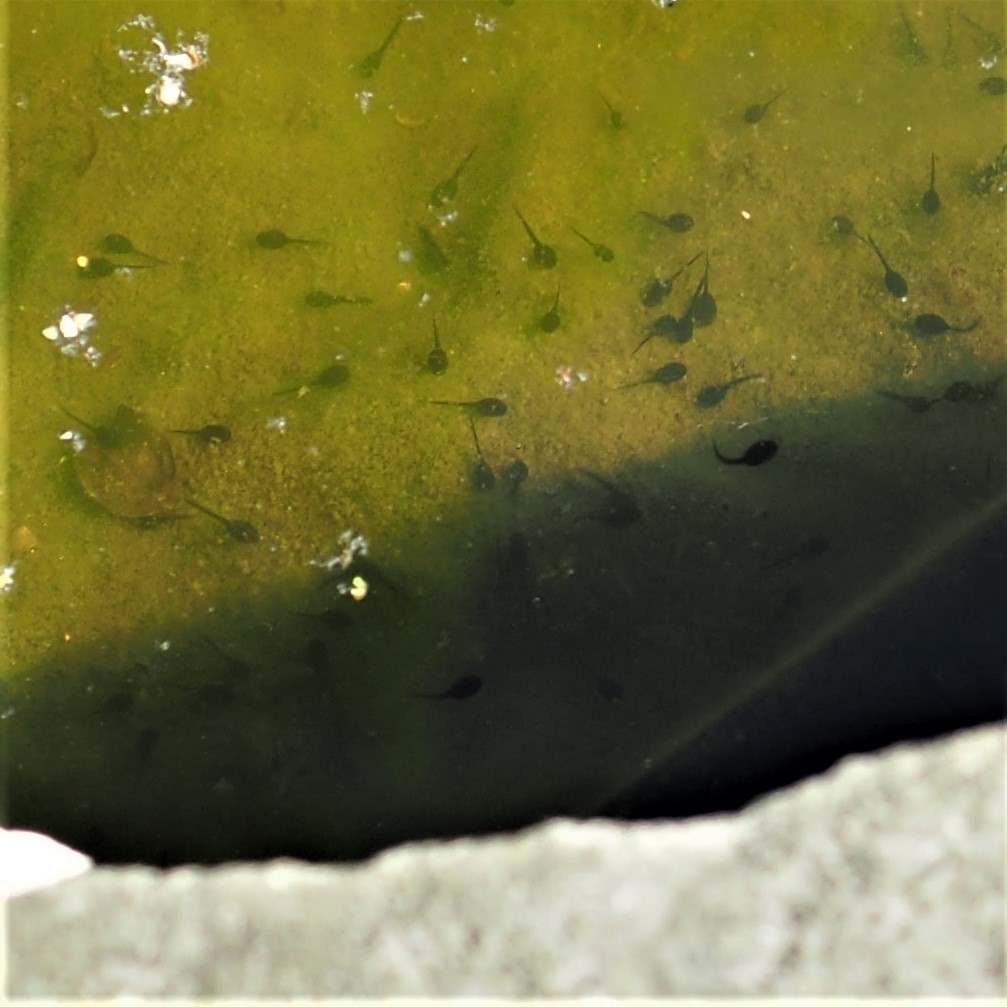
We had a few little Wasps. I'm sorry, I haven't identified any of them permanently.
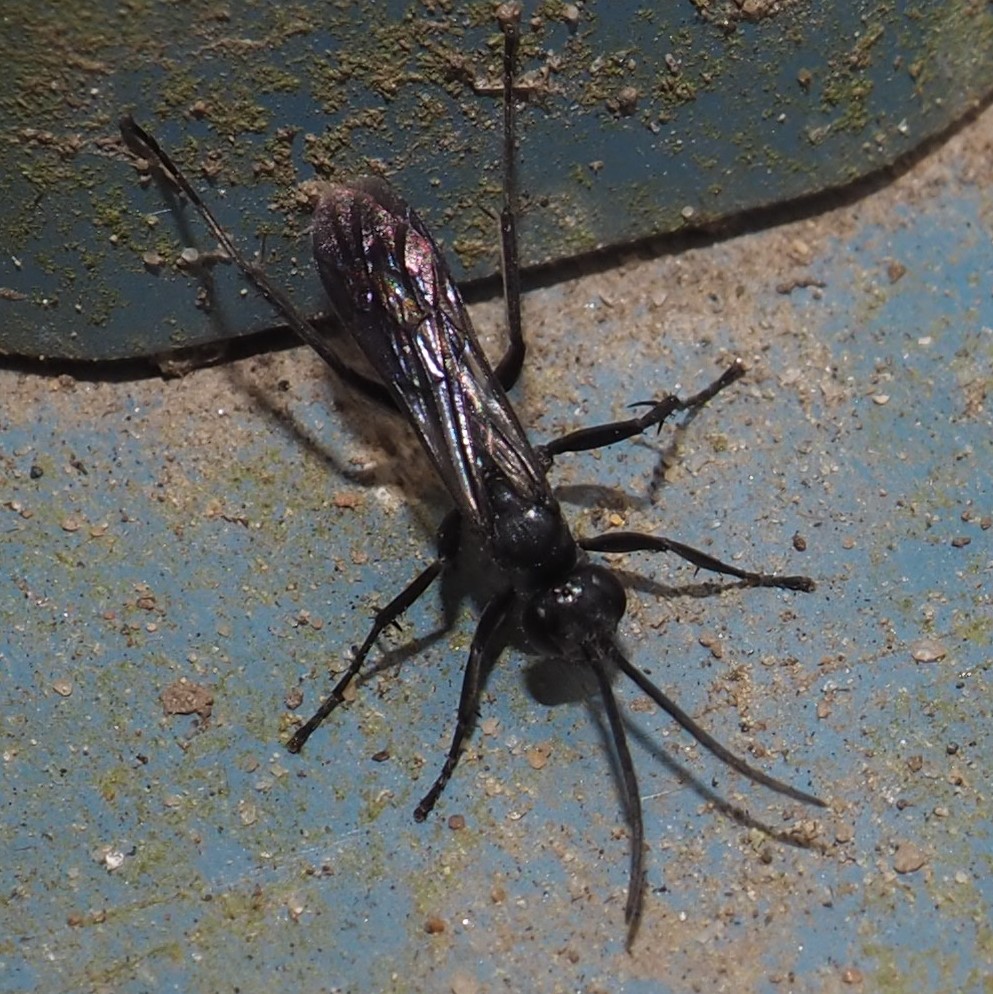
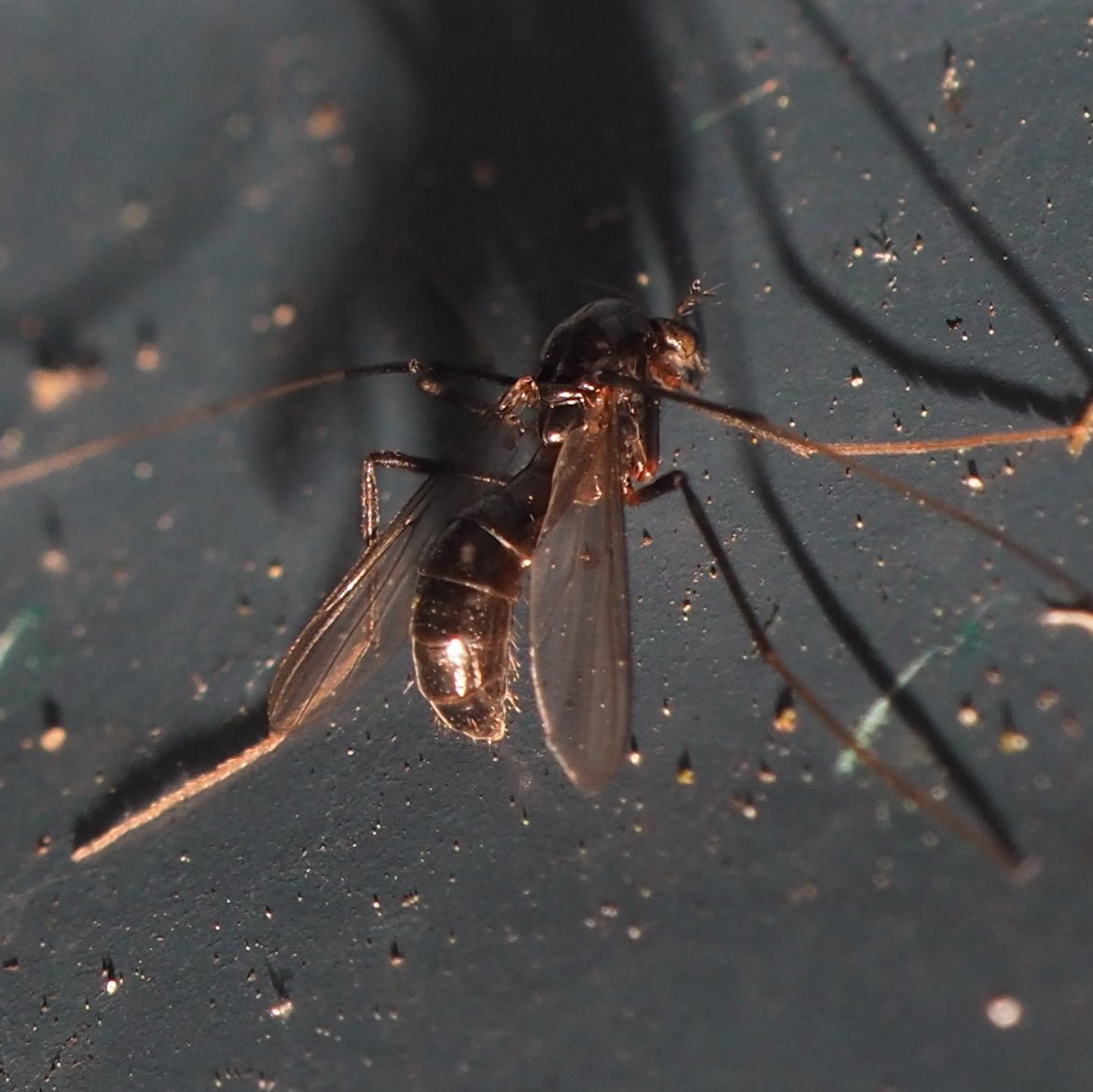
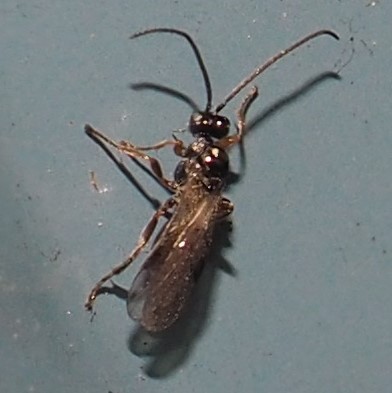
The only ones in this row that I could identify are: third, female European Paper Wasp; and fourth, an Eastern Yellowjacket Queen, seemingly trying to find a hole behind a crack in the Front Porch brickwork.
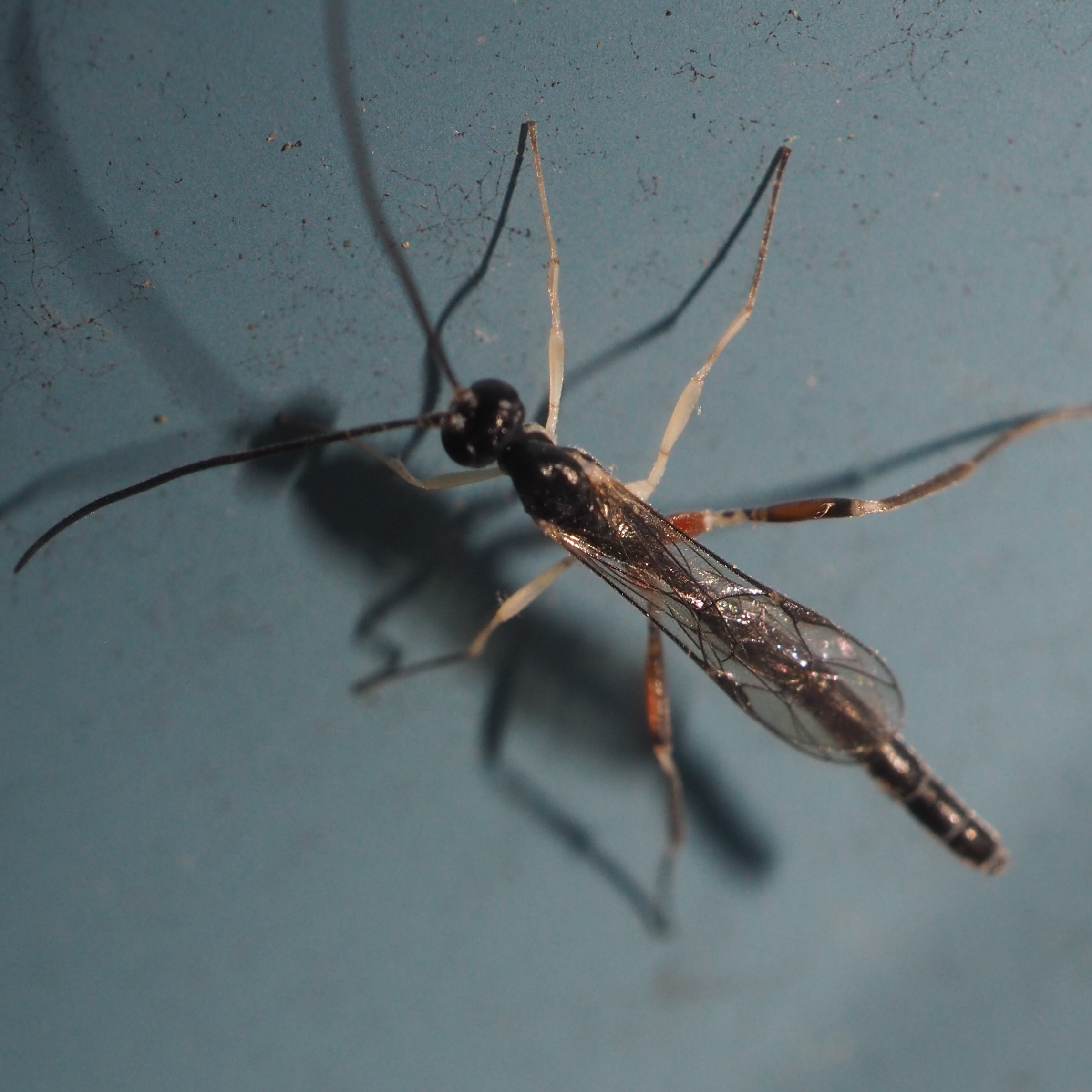

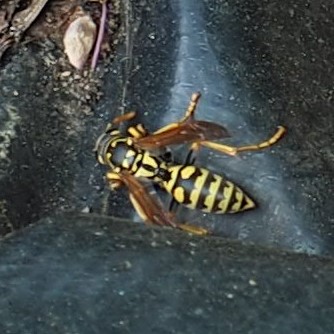
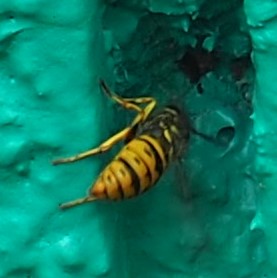
I liked those Weevils so much, here are a few color-morphs of one of them. Feel free to use them with attribution. :-)



It has been wonderful getting out to a few gatherings with immunized friends. I've especially enjoyed dinner with a couple of old friends and the Film Club and AALL Film Class! Now to get together with a few more people and it will seem much more like normal times. We have to remember that these STILL aren't truly normal times and be careful, but try to let our brains relax so that the GOOD things have a way in!
Love, Martha
Back to May 23, 2021
Forward to June 6, 2021
Back to main menu
copyright Martha O'Kennon 2021















































































































